Archive for the ‘Blue Mountains (AU)’ Category
Wednesday, November 27th, 2013
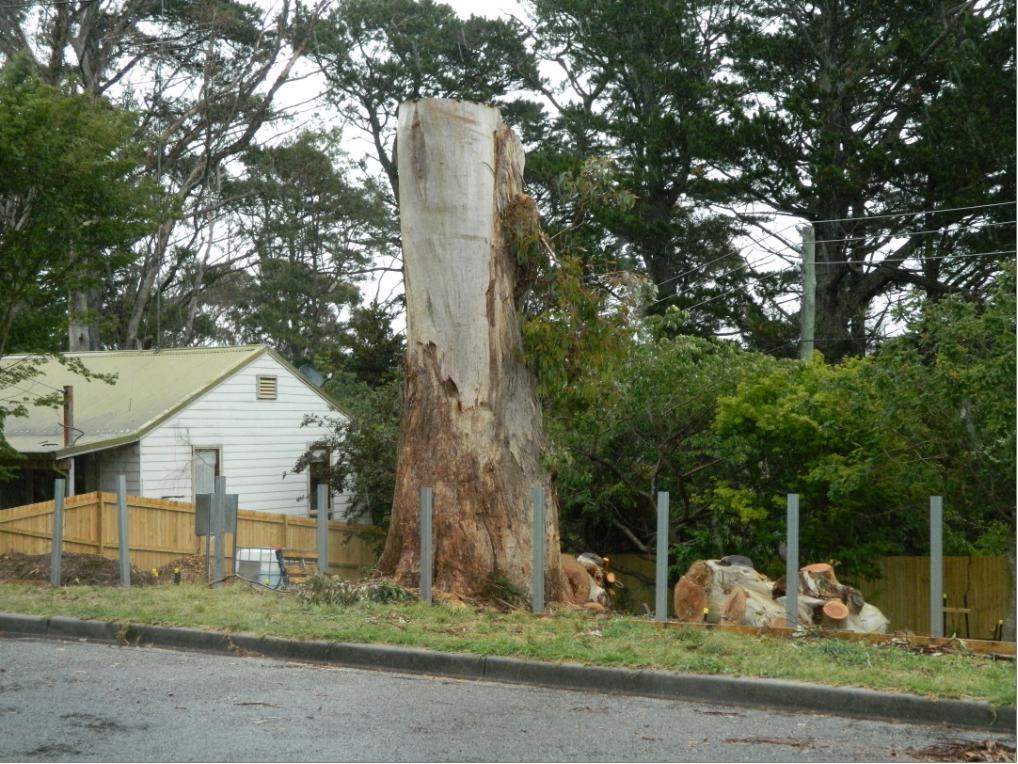 A rare and perhaps 150 year old and healthy endemic Eucalpytus Oreades tree
Land buyer: “Hey Asplundh, it’s in the way of where I want to build a house to sell for profit.” A rare and perhaps 150 year old and healthy endemic Eucalpytus Oreades tree
Land buyer: “Hey Asplundh, it’s in the way of where I want to build a house to sell for profit.”
.
Our Investigative Journalist: “I think the E.Oreades was chopped down today (20131125) , as I heard a chainsaw coming from Loftus St.”
When 17 year olds were cut down in the prime of their life during The Great War for no reason or for someone else’s evil ends, all involved governments just sent in more to top up the slaughter with the stroke of a polly pen.
When it comes to preservating ecological life worth living, Blue Mountains Council in 2013 belongs to that same callous mindset. They continue to proclaim being a City within a World Heritage Area.
God knows why.
.
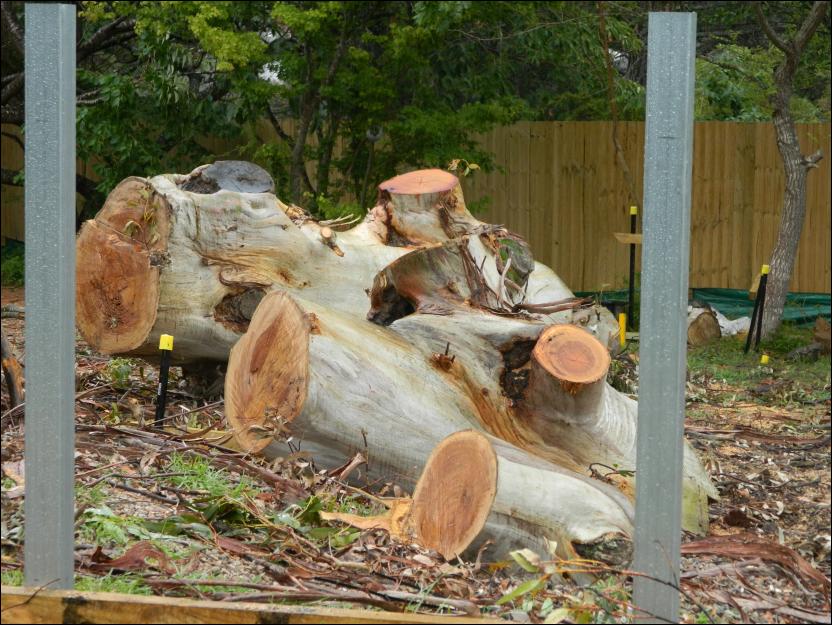 A healthy specimen of an Oreades with no signs of disease or rot.
We consider that what took place in Loftus Street Katoomba, Blue Mountains on Monday 25th November 2013, was an act of callous ecological murder
A healthy specimen of an Oreades with no signs of disease or rot.
We consider that what took place in Loftus Street Katoomba, Blue Mountains on Monday 25th November 2013, was an act of callous ecological murder
by Asplundh for one property developer’s personal greed.
.
“All that is necessary for the triumph of evil is that good men do nothing.”
.
~ Edmund Burke PC (b.1729) an Irish statesman, author, orator, political theorist and philosopher.
.
Saturday, November 16th, 2013
 Abject failure by emergency MANAGEMENT
Buena Vista Road, Winmalee, Blue Mountains, 18th October 2013 Abject failure by emergency MANAGEMENT
Buena Vista Road, Winmalee, Blue Mountains, 18th October 2013
In anyone’s assessment, except for those in charge, 193 homes lost with 109 damaged is not a firefighting success for the unlucky Blue Mountains communities of Springwood/Winmalee, Yellow Rock and Mount Victoria.
.
How often do bushfire fighters have to watch on in frustration from their fire trucks on a road towards a bushfire, knowing they are helpless with the tools they have to extinguish it?
In the case of a single house fire in an urban setting, the fire truck is the tried and tested appropriate appliance to respond. Fire fighters can readily drive up to and park right out the front and hose down a house fire. But applying this classic firefighting method to wildfires in expansive and rugged bushland with steep and often inaccessible terrain is all but useless, like square peg in round hole thinking.
Yet whenever government announces pre-election funding to bushfire fighting it is kneejerk unimaginatively more fire trucks, costing millions and fixing nothing.
It comes down to political value judgment.
.
 Water, water, in fire trucks everywhere, nor any drop to douse the fires
with apologies to English poet Samuel Taylor Coleridge in his 1798 poem, ‘The Rime of the Ancyent Marinere’.
Water, water, in fire trucks everywhere, nor any drop to douse the fires
with apologies to English poet Samuel Taylor Coleridge in his 1798 poem, ‘The Rime of the Ancyent Marinere’.
.
Many wildfires spark from lightning strikes in remote terrain and spread into hilly bushland with few access roads. More so these days, the disturbing arson fetish has become more deadly.
The consequential wildfires in inaccessible bushland country logistically render the fire truck ineffectual as the prime bushfire fighting response. Fire trucks despatched down along fire trails that are surrounded by bushland on RFS maps provide a false sense of access and ability, but they are death traps for firefighters in fire trucks during a wildfire in extreme conditions.
Just last September during the Londonderry grassfire in outer western Sydney, a fire truck along an outer urban road was overcome by flames and destroyed. It wasn’t even a fire trail.
.
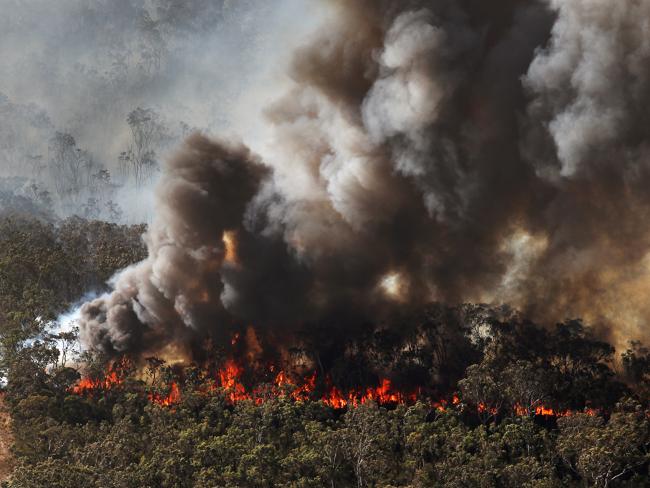 Wildfire beyond the reach of fire trucks through Windsor Downs Nature Reserve, western Sydney, September 2013
[Source: ^http://www.dailytelegraph.com.au/news/one-hell-of-a-start-to-an-early-summer-as-firestorms-sweep-across-nsw/story-fni0cx4q-1226716072987 ] Wildfire beyond the reach of fire trucks through Windsor Downs Nature Reserve, western Sydney, September 2013
[Source: ^http://www.dailytelegraph.com.au/news/one-hell-of-a-start-to-an-early-summer-as-firestorms-sweep-across-nsw/story-fni0cx4q-1226716072987 ]
.
This is where fast targeted airborne response within the first hour of ignition is more effective. The application of large quantities water bombing of a fire front is surely the preferred lead bushfire fighting response strategy. This is not to say that ground support is not needed, but the evidence is that traditional truck based ground support as the lead response strategy is simply not cutting the mustard.
But such strategy requires considerable investment and planning and requires expertise. It demands a military standard realignment of the emergency response co-ordination end-to-end from early warning systems monitoring, to ignition detection, to fast airborne response with all the latest communications technology available. Clearly this is well beyond the volunteer business-as-usual bush firefighting model that governments have lackadaisically drip fed since colonial times.
On Thursday 17th October 2013, at around 2pm, a bushfire started upwind in Springwood in the Blue Mountains in New South Wales. The fire was purportedly ignited by arcing of touching residential overhead powerlines in strong wind conditions. The Sydney Morning Herald ran a story a few days later on Sunday 20th October, that preliminary investigations had found that a tree with cables running through its branches is believed to be the seat of the fire that jumped a road then engulfed houses in Springwood, spotting over to Winmalee and Yellow Rock.
Coincidentally, a few days prior to the wildfire tragedies of Thursday 17th that separately impacted Winmalee, Yellow Rock and Mount Victoria, on 15th October New South Wales Premier Barry O’Farrell had publicly announced the arrival of an additional large firefighting Air-Crane helicopter to be leased from of all places, impoverished Greece.
Nicknamed the ‘Gypsy Lady‘, this lifesaving Erickson S-64 Air-Crane has deserved fame for its massive water bombing ability beyond any Dad’s Army Isuzu truck.
O’Farrell apparently immediately deployed it to fight bush fires according to government propaganda and photos are offered of it in action at Winmalee. But did it? So where was it and a second leased Air-Crane, ‘Elvis’, deployed on the critical multiple wildfire afternoon of Thursday 17th October?
Such government performance facts are kept secret from the public. The government’s promotional photo below of an Air-Crane water bombing bushland over Winmalee was dated Wednesday 23rd October, extinguishing left over spot fires a week later. So where is the smoke? Where there is no smoke there is probably no fire. Was this photo for the media’s benefit? The caption for this photograph reads verbatim as follows:
“A firefighter looks on as Air-Crane Elvis drops water at the Linksview Road fire near Faulconbridge, in the Blue Mountains (sic) 23/10/2103 (AAP: Lukas Coch).”
.
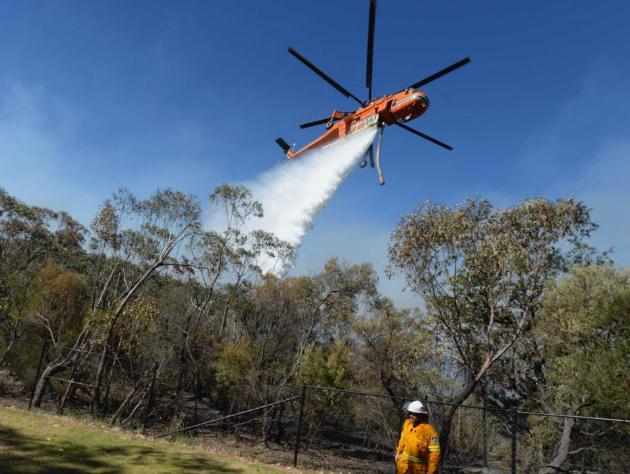 Game Changer
We can save you, if we are called in early enough.
The ‘Elvis’ Air-Crane over Winmalee, except the NSW Government’s promotional photo is dated 23rd October 2103?
[Source: ‘NSW bushfires: Crews battle to contain destructive blazes in Lithgow and Springwood’, 20131020, ABC, ^http://www.abc.net.au/news/2013-10-19/fire-crews-battle-blazes-in-lithgow-and-springwood/5033558]
Game Changer
We can save you, if we are called in early enough.
The ‘Elvis’ Air-Crane over Winmalee, except the NSW Government’s promotional photo is dated 23rd October 2103?
[Source: ‘NSW bushfires: Crews battle to contain destructive blazes in Lithgow and Springwood’, 20131020, ABC, ^http://www.abc.net.au/news/2013-10-19/fire-crews-battle-blazes-in-lithgow-and-springwood/5033558]
.
It was reported two days after Blue Mountains residents tragically lost over 200 family homes to the bushfires, that a crucial water bombing Erickson S-64 Air-Crane had been grounded at Bankstown Airport during the two day bushfire crisis, because authorities claimed they needed an American engineering and flight crew to operate it.
But then still without such American crews on Saturday 19th October, the Air-Crane was authorised to fly to Springwood, despite the absence of the US crew.
While it will now be used to assist in combatting ongoing fire hazards, the water dumper was forced to sit idle while bushfires ravaged the state on Thursday, Friday and most of yesterday. The craft is believed to be the same chopper, nicknamed ‘Ichabod‘, which was flown over on a cargo plane with the previously mentioned helicopter, ‘Gypsy Lady‘ since has been put to use – from Greece to Sydney Airport.
Previously, a qualified American team arrives with the helicopter, enabling it to operate, however the team for the Ichabod were only due to fly to Australia at a later date. As bushfires started earlier than expected, authorities were caught off-guard and forced to scramble without the use of the second craft.
The Erickson S-64 Air-Crane helicopters are able to waterbomb a fire with 10,000 litres of water and are frequently brought to Australia from the United States for the bushfire season and hot weather. But due to the Erickson Air-Crane’s absence from the fire front, ordinary choppers used by the RFS were mobilised. However it’s understand those replacement craft can only dump 300 litres of water, just 3% of that of the Erickson Air-Crane.
[Source: ‘Critical US water bomber grounded during NSW bushfire crisis’, by Yoni Bashan, State Political Reporter, The Sunday Telegraph, 20131019, ^http://www.dailytelegraph.com.au/news/nsw/critical-us-water-bomber-grounded-during-nsw-bushfire-crisis/story-fni0cx12-1226743108424]
.
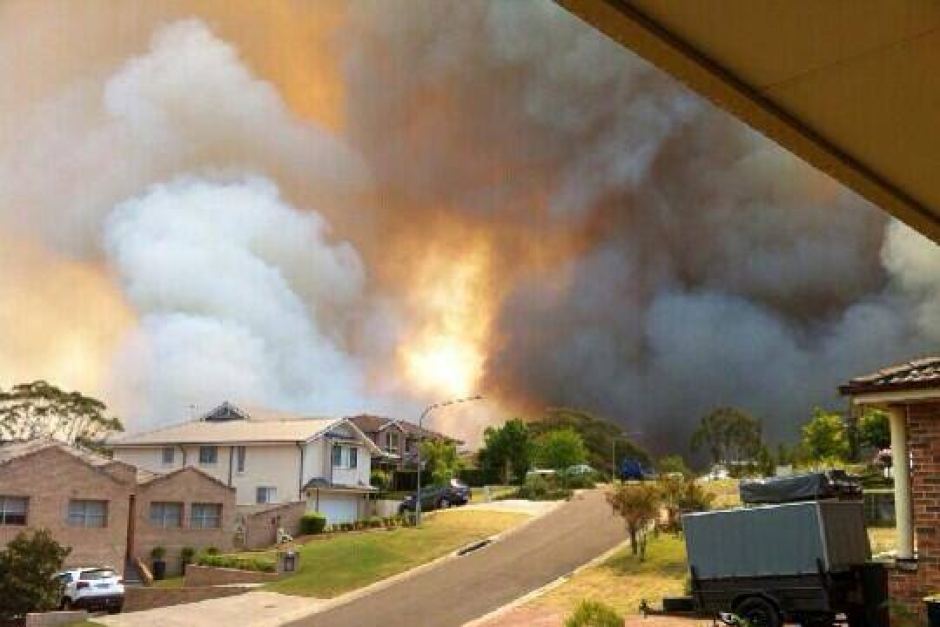 Springwood, 17th October 2013
Evacuate to where? We’re at work in the city so how can we save our valuables in time?
We have no alternate accommodation as the bloody government presumes.
We can’t afford insurance. Springwood, 17th October 2013
Evacuate to where? We’re at work in the city so how can we save our valuables in time?
We have no alternate accommodation as the bloody government presumes.
We can’t afford insurance.
.
So on the 17th October the Blue Mountains bushfires escaped ground control, leading to at least 193 homes lost and at least another 109 damaged and 3,500 hectares of bushland burnt with uncounted wildlife incinerated. The wildlife cost is always ignored.
No facts are forthcoming from the New South Wales Government about the performance of the firefighting. Why not?
- What was the estimated time of ignitions respectively at Winmalee and Yellow Rock?
- How was each wildfire reported and detected by the authorities?
- What was the elapsed time from the estimated ignition times and the respective times the RFS became alerted?
- What was the elapsed time from the estimated ignition times and the RFS response being despatched (leaving the depots)?
- What was the elapsed time from the estimated ignition times and the RFS response arriving on site to suppress the respective wildfires?
- What time was the first house impacted by wildfire?
- What time did airborne water bombing on the wildfires commence?
- What time did aircrane water bombing on the wildfires commence?
.
Such facts are not in the government’s interest to publish because it well knows that its gross under-resourcing of bushfire emergency management exposes it to negligence and cost demands.
It comes down to political value judgment.
.
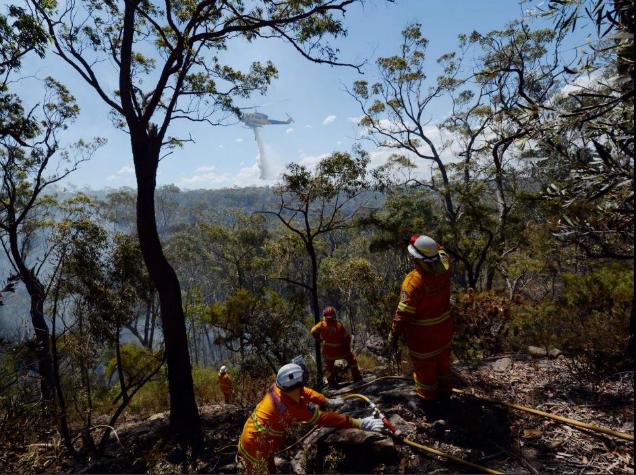 3% water capacity airborne response simply too little too late 3% water capacity airborne response simply too little too late
.
Year on year wildfire and deliberately lit hazard reductions escape control and cause the incineration of vast swathes of the remaining natural landscape. Some years people and their homes are lucky, moreso a factor of mild weather than emergency management performance. In 2009 it was Victoria’s unlucky turn.
Across Australia, bushfire detection, response and suppression is repeatedly shown to be so woeful as to be incompetent.
Government avoidance of seriously effective investment into emergency management, sees it instead resort to credibility damage control propaganda and to playing politics. It hides behind the goodwill of the volunteers, since anyone who dares criticise the performance of noble volunteers can only be publicly vilified. The government resorts to defeatist attribution of the bushfire emergency to uncontrollable Acts of God – catastrophic weather conditions in which nothing we can do would make any difference. It runs public announcements of impending Armageddon, Declares a State of Emergency as if it were 1939 Black Friday every summer and its emergency services head are instructed to do supportive drama queen performances.
Now around where the fires started there is little bushland left and little reason to stay. House values are down and people are selling up and moving off Mountains.
Government’s think their shit never stinks. Paid ambulance emergency response have a service charter to arrive on site after a 000 call within 20 minutes. But bushfire fighting has no such accountable charter. Rather the government’s emergency response duty is delegated to local volunteers charged to do their best with what they’ve got.
Typically, Rural Fire Service bushfire fighters, except for a few government paid white shirts in Homebush, are invariably unpaid volunteer members of the local community. When an emergency 000 call from a member of the public is despatched to the local brigades, the volunteers pre-occupied with their paid day jobs and have to drop everything. They are not paid to be on standby at fire brigade depots like the NSW Fire Brigades, irrespective of heightened times of high bushfire risk. The volunteers are not paid by government at all, and have to rely upon local charities for food and even for bottled water.
The last resort of the under-resourced bushfire brigades is to fight fire with fire.
.
 Scorched Earthing has become the last sad firefighting bastion of second class firefighters denied effective resources. Forced to fight slaughter with slaughter, or cruelty with hate. Scorched Earthing has become the last sad firefighting bastion of second class firefighters denied effective resources. Forced to fight slaughter with slaughter, or cruelty with hate.
.
The Greater Blue Mountains continues to be torched and scarred by its own custodian the National Parks and Wildlife Service. Its habitat and wildlife are being incinerated without measure or care.
Just like the mining and farming pollution impacts upon the integrity of the once Great Barrier Reef, the Greater Blue Mountains natural values are been irreversibly altered. Both the Great Barrier Reef and the Greater Blue Mountains need a cry for help and be added to UNESCO’s endangered list.
But putting Australia on an international ‘list of shame’ is but a small price. It comes down to political value judgment.
.
[The author is a licensed commercial helicopter pilot]
.
Tuesday, November 12th, 2013
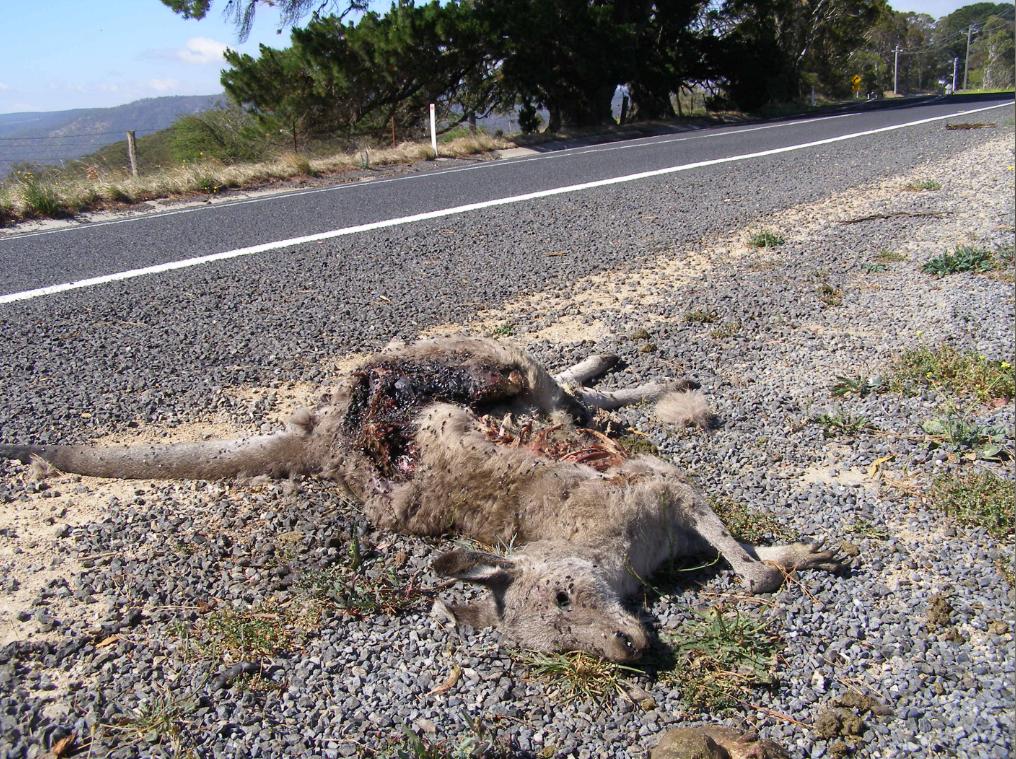 Australian roadkill on the Jenolan Caves Road to Oberon
west of the Blue Mountains, New South Wales
[Photo by Editor 20131109, © under ^Creative Commons] Australian roadkill on the Jenolan Caves Road to Oberon
west of the Blue Mountains, New South Wales
[Photo by Editor 20131109, © under ^Creative Commons]
.
Taking the tourist drive out to Oberon last weekend, we must have counted two dozen dead, mangled and fly blown Australian animals along the roadside. Kangaroos and wombats mainly; and a few feral cats and foxes.
It was a bizarre ‘Welcome to Oberon’ along the Jenolan Caves Road and then along the Duckmaloi Road into the logging and quarry town of Oberon.
We first passed by Hytec’s Austen Quarry outside Hartley which carves into the hillside to produce road making aggregate crushed rock.
.
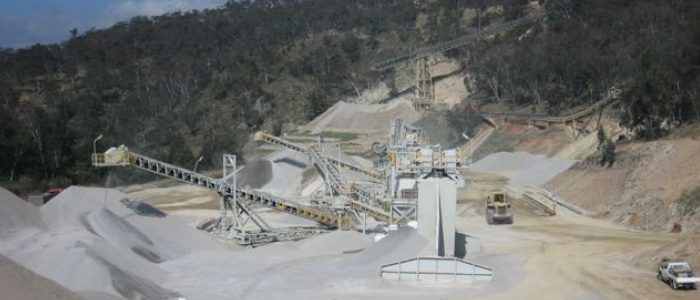 Hytec’s Austen Quarry
Jenolan Caves Road
[Source: ^http://www.hy-tec.com.au/products/Aggregates/austen.aspx] Hytec’s Austen Quarry
Jenolan Caves Road
[Source: ^http://www.hy-tec.com.au/products/Aggregates/austen.aspx]
.
We passed by this fly-blown wombat grossly mangled by the massive B-double sand trucks.
.
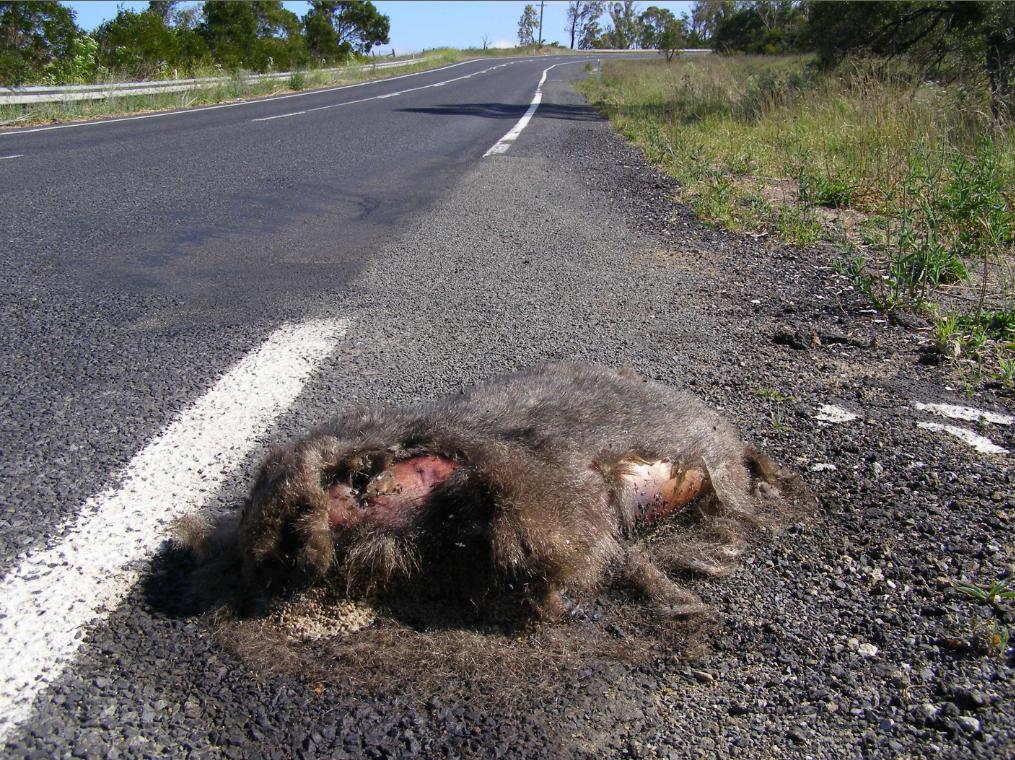 What’s left of a Wombat
Jenolan Caves Road
[Photo by Editor 20131109, © under ^Creative Commons] What’s left of a Wombat
Jenolan Caves Road
[Photo by Editor 20131109, © under ^Creative Commons]
.
The B-doubles hoon along as if racing motorbikes. We were tailgate bullied by one on the road out to Oberon. The B-double sand trucks travel through the night at speed and so the wildlife has no chance.
.
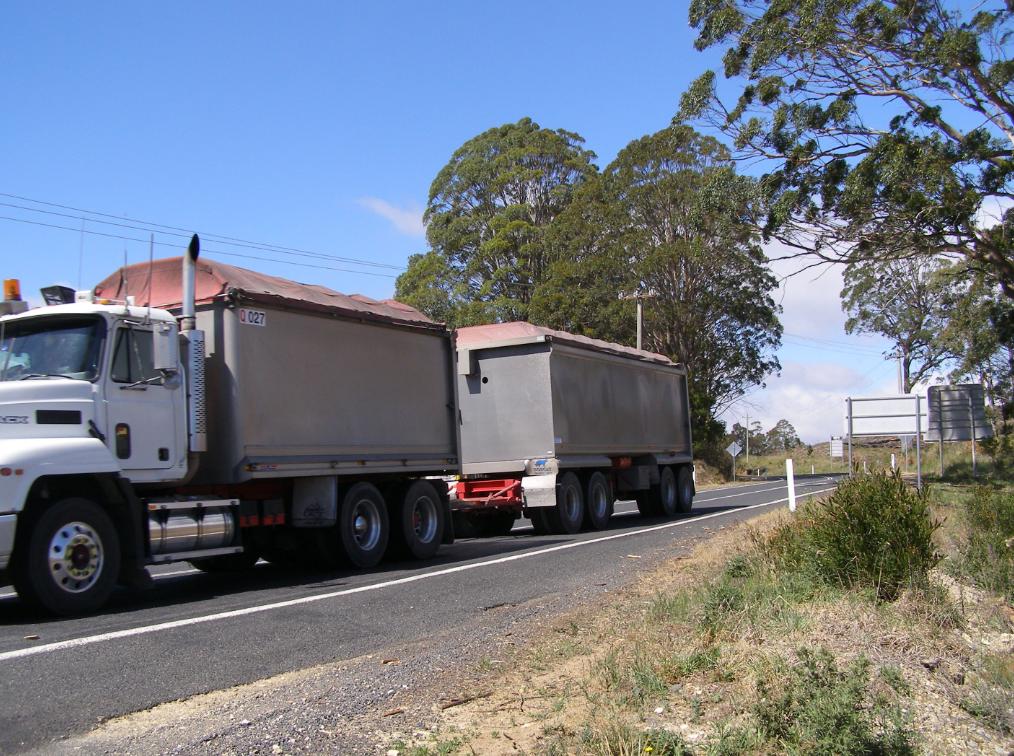 Duckmaloi Road to Oberon
[Photo by Editor 20131109, © under ^Creative Commons] Duckmaloi Road to Oberon
[Photo by Editor 20131109, © under ^Creative Commons]
.
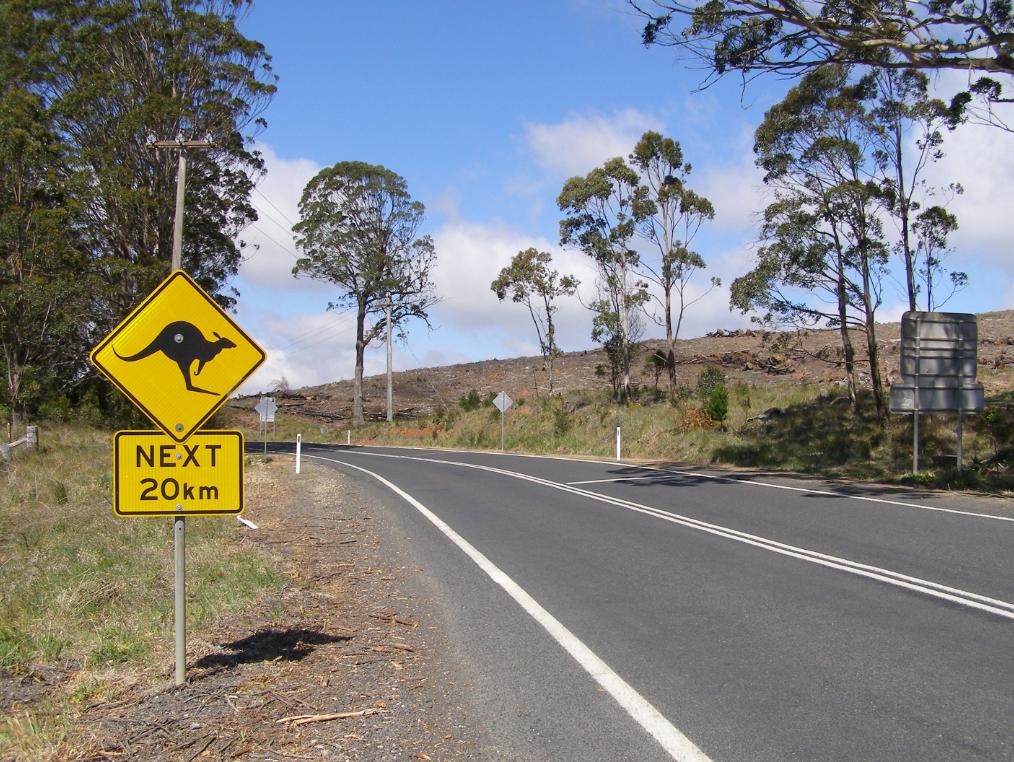 Kangaroo sign more of a token gesture
Situated on the Jenolan Caves Road opposite clearfell native forest.
[Photo by Editor 20131109, © under ^Creative Commons] Kangaroo sign more of a token gesture
Situated on the Jenolan Caves Road opposite clearfell native forest.
[Photo by Editor 20131109, © under ^Creative Commons]
.
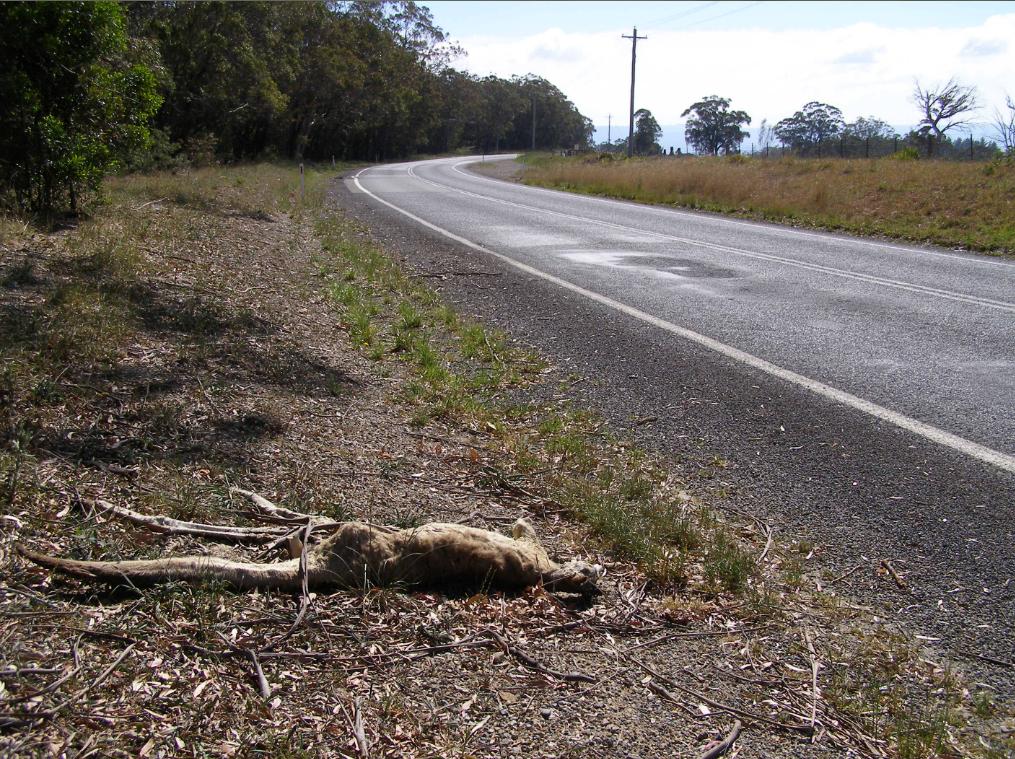 Less kangaroos next 20km
Jenolan Caves Road
[Photo by Editor 20131109, © under ^Creative Commons] Less kangaroos next 20km
Jenolan Caves Road
[Photo by Editor 20131109, © under ^Creative Commons]
.
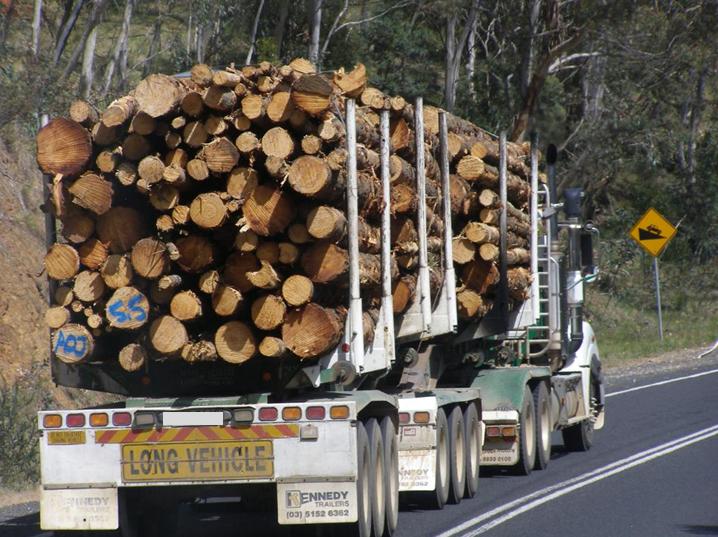 B-Double Logging Truck
Loaded up from Jenolan State Forest, along the Duckmaloi Road to Oberon’s Timber Mill
[Photo by Editor 20131109, © under ^Creative Commons] B-Double Logging Truck
Loaded up from Jenolan State Forest, along the Duckmaloi Road to Oberon’s Timber Mill
[Photo by Editor 20131109, © under ^Creative Commons]
.
One Oberon based tourism operator promotes things to do around Oberon thus:
“Explore the spectacular Blue Mountains High Country on horseback and quad bikes, ride beneath a canopy of pine forests, marvel at the unspoiled bushland, gaze into a crystal clear creek, breathe the clean mountain air.”
.
Sunday, November 10th, 2013
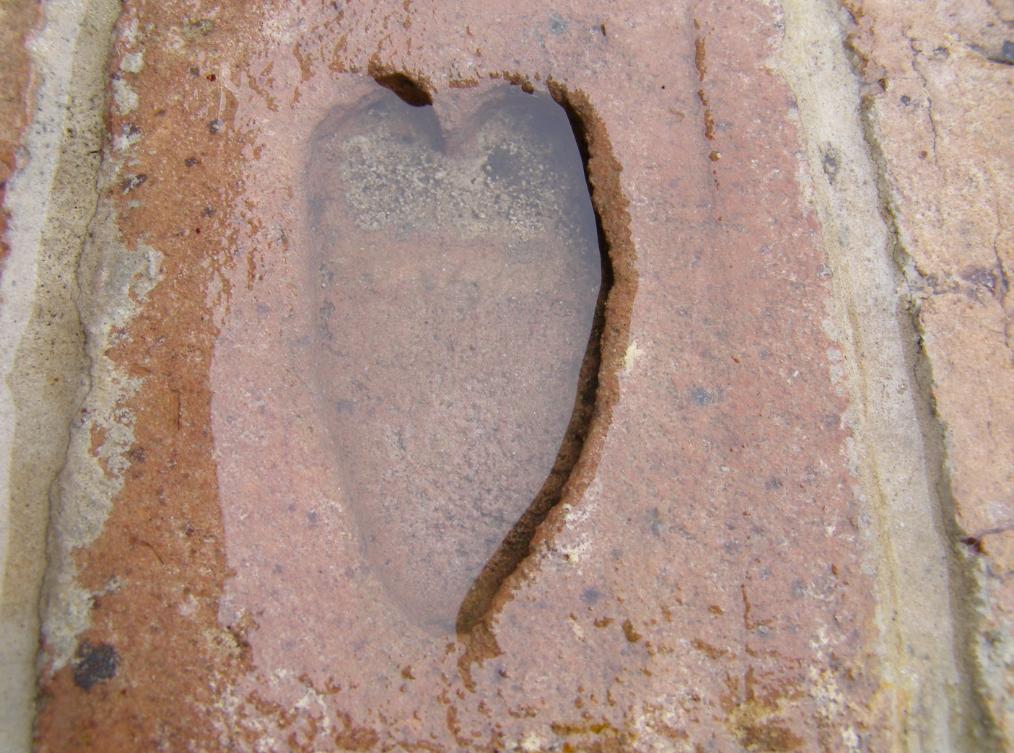 Our home’s lucky John Clew heart bricks, today full of drenching rain water
[Photo by Editor, 20131110, photo © under ^Creative Commons] Our home’s lucky John Clew heart bricks, today full of drenching rain water
[Photo by Editor, 20131110, photo © under ^Creative Commons]
.
It’s very wet. It’s actually soaking wet up here in the Blue Mountains. How welcoming are the rains? They took long enough. Poor bloody bush has been long parched out there; too parched, too tinder dry. Now the rains are over us and they are staying for while, and they can stay as long as they like.
Some dates stick in one’s mind. Friday 12th October 2012 is a date that I have personally etched into my memory. It was the day that constant snow suddenly blanketed the Upper Blue Mountains out of nowhere. The snow on the ground was a foot thick and we lost tree branches to the weight of it. It was a memorable Friday, as it no longer snows up here.
Apparently, it used to snow most winters in the Upper Blue Mountains. Living memory recalls that a few opportunistic locals even once skiied down Katoomba Street during Winter Magic.
Residents of the townships of Winmalee and Mount Victoria in the Blue Mountains will now remember Thursday 17th October 2013, but not for happy times. It was an awful day. For those affected and involved likely the worst ever. Out of nowhere separate wildfires suddenly ravaged through their communities and took away many homes and memories.
I have happened to drive past Linksview Road involuntary over recent days. Passing by incinerated homes just off the side of the road feels voyeuristic and so immoral. Luck is perhaps a curse, like pretending routine life-as-usual between others’ total loss. No way.
None of it’s fair to anyone affected or not affected but no less it about Mountains folk not knowing what to say or do for the blackened ruins down the street. Nothing wrong with outpouring and I think it is a right.
Only the firies know it could have been worse.
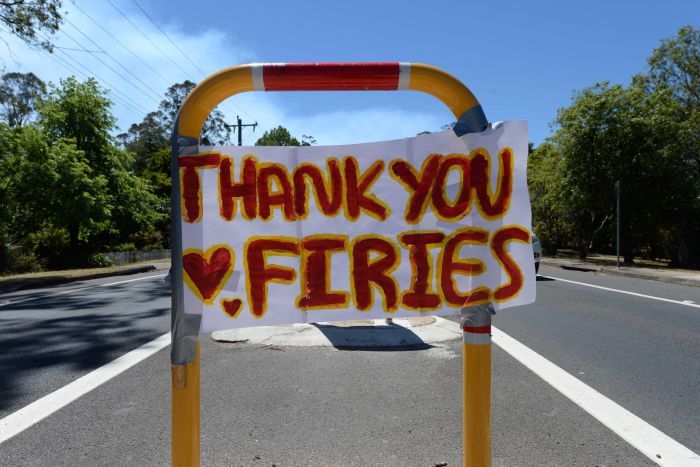
And I shouldn’t have driven down St Georges Parade yesterday on the way home, but I wanted to just to know the trauma hidden off limits by the authorities. Now its incinerated street and homes haunt me. I walked this street just after the 2006 Grose Fires, observing the hazard reduction above Lawsons Long Alley. Many new homes on a no through road ridge nestled above Blue Mountains bush. Bloody lucky then.
I awoke very early this morning realising how lucky I am as one of the 99.9% of Blue Mountains residents with a home, just as per usual. For us it is life as usual and we have rain on our roof. It is because we have a roof and a house.
Over three hundred residents this time on the morning of the 17th October did too like me, but since then they no longer do. I can’t imagine the ravage and the total loss. But I write this because catastrophe needs to be said because it is just that. All Blue Mountains people need to be affected by the incinerated homes down sealed off crime scene streets that could have been theirs.
If I had lost my home, I expect that I would not be in a state to write coherently, but I am so I choose to because I take an active interest. I witnessed wildfire threaten my home in 2001, seeing my garden hose drizzle to a horrifying dribble rendering me castratingly helpless and useless. I have taken an empathetic very personal interest in bushfire threats ever since.
My father lost his entire family records in a garage fire when I was 18. He was probably devastated at the time, but I don’t recall him expressing or showing grief because he was probably brave facing to us kids and probably because of my immature age. Over time he realised that the now and family are most important to one’s life. He has re-affirmed this over the subsequent years, with time and with a strength of family to move on. Sounds easy and simple in hindsight, but hindsight is what the memories are about, and as part of our survival instinct we tend to recall in most detail the good times, and confine the bad times to snippets.
Now that today, three week’s hence the rains are over us, I can happily stand under them and get happily soaked quite eccentrically for all it matters. So what matters at the end of the day when the sympathy has packed up and move on?
It is about why we made the choice and it was a soul thing. We live for hope and so we should. We live in the Blue Mountains because we choose because the Mountains are a special place for reasons us here know.
Bless you.
.  A memorable sunny day at a Blue Mountains Winter Magic
A memorable sunny day at a Blue Mountains Winter Magic
[Photo by Editor, 20080621, photo © under ^Creative Commons]
.
It is 2013 and we are to become wise, in our own time.
.
Tuesday, November 5th, 2013
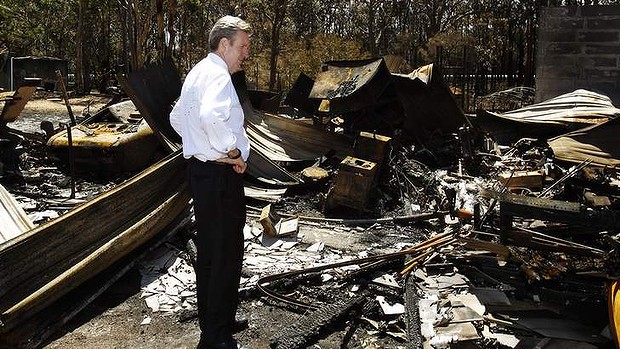 “This will be as bad as it gets”
So we kicked ass better than the Victorians in 2009,
we only had two deaths “This will be as bad as it gets”
So we kicked ass better than the Victorians in 2009,
we only had two deaths
.
The State Mine Bushfire
.
On Wednesday afternoon 16 October 2013, government Defence Force recklessly over-indulged in a live munitions exercise at the Marrangaroo army range. The range is situated on the outskirts of the town of Lithgow, New South Wales, upwind of the Greater Blue Mountains World Heritage Area. The exercised directly sparked a fire in dry grass on the range. Fanned by strong, hot, westerly winds it rapidly moved eastwards to the forested hillside on the northern side of Lithgow.
The fire spread into bushland and over the following week extended out of control burning out most of the northern region of the Blue Mountains National Park, parts of Wollemi National Park, and triggered the evacuation of most of the Lithgow region. The communities affected included Bell, Berambing, Bilpin, Clarence, Dargan, Hartley Vale, Lithgow, McKellars Park, Mount Irvine, and Mount Wilson. The fire burnt out more than 55,000 hectares (140,000 acres) between Lithgow and Bilpin.
Rural Fire Service Dad’s Army suppression delays meant that instead of waterbombing a small grassfire on the 16th, what was allowed to grow into a massive wildfire front saw fire bombing of vast hillsides in a multi-flank head burning response. Many more thousands of hectares of bushland habitat in and around the Greater Blue Mountains World Heritage Area were incinerated. But the total area of fire impact has not been made public by the RFS.
During that week fighting fires across New South Wales, two men tragically died. A 63-year-old man suffered a heart attack while fighting a fire at his home at Lake Munmorah on the Central Coast. Agricultural Pilot David Black, 43, from Trangie in the Central NSW died when his Dromader aircraft crashed while contracted to the RFS to waterbomb the Wirritin Ridge Bushfire in the Budawang National Park.
.
<< ”This will be as bad as it gets,” Rural Fire Service Commissioner Shane Fitzsimmons said. ”On days like [this], there’s a very real potential for more loss of homes and life. There’s is real potential for more homes and lives lost on Wednesday, says the NSW Rural Fire Commissioner.
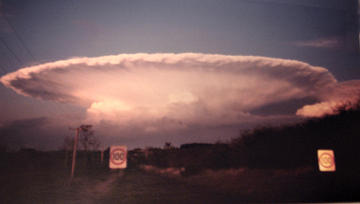 RFS Armageddon RFS Armageddon
.
Weather worse than the extremes already predicted, combined with large bushfires burning out of control, and the real potential for others to spark up, have prompted a very grim warning. The RFS had warned since the weekend about the potential devastation Wednesday’s weather could cause but the revised forecast on Tuesday was even more worrying, Mr Fitzsimmons said.
Wednesday would be hotter, drier and windier than the dire predictions previously forecast, posing a grave challenge to one of the largest firefighting contingents assembled in NSW history. They would have to battle an active 1500-kilometre fire edge in the Blue Mountains where three major fires, one at Bilpin now linked to the second at Mount Victoria and a third at Springwood, burned out of control. ”It’s a difficult, dynamic, dangerous fire-ground situation,” Mr Fitzsimmons said. >>
.
[Source: ‘This will be as bad as it gets’: Blue Mountains fire crews prepare for the worst‘, 20131022, by Nick Ralston, Emma Partridge, Sydney Morning Herald, ^http://www.smh.com.au/environment/weather/this-will-be-as-bad-as-it-gets-blue-mountains-fire-crews-prepare-for-the-worst-20131022-2vz3h.html]
.
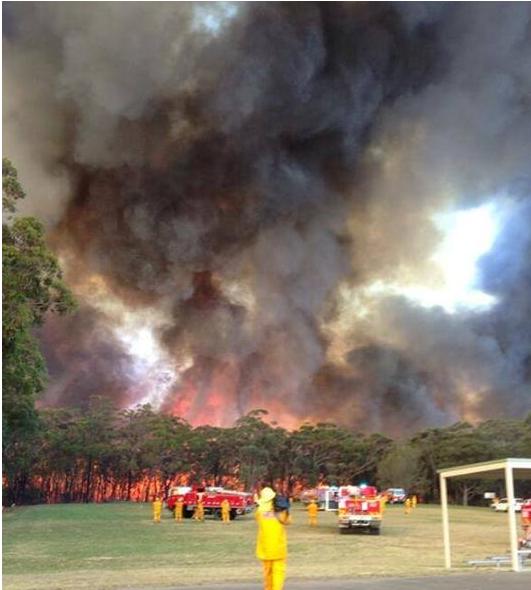 RFS Homebush doing staged PR shoot…when?
RFS Homebush doing staged PR shoot…when?
.
<< Two weeks after the worst of NSW’s bushfire emergency, the O’Farrell Government is refusing to say whether it will consider burying power lines in fire-prone areas or buy back properties razed in risky locations – key responses to the Black Saturday fires.
The Rural Fire Service says a power line started a blaze that jumped a road and then engulfed almost 200 houses at Springwood, Winmalee and Yellow Rock in the Blue Mountains on October 17.
Fallen or damaged power lines caused most of the 173 deaths in Victoria’s Black Saturday disaster of 2009. After the royal commission on those fires recommended action to address overhead power lines, the state government announced a $1 billion plan to replace them with underground cables.
That royal commission also recommended the government buy back houses in areas at extreme fire risk, and Victoria has spent $25.6 million on 116 properties. Some of the land will be sold to surrounding neighbours, who will use it as a buffer between the bush and their homes.
On Tuesday, Fairfax Media sent specific questions about power lines and property buy-backs to Emergency Services Minister Mike Gallacher. The Planning Department responded but did not address the questions, instead saying NSW had the toughest bushfire planning approvals regime in Australia.
When pressed on the need for a ministerial response, his spokesman said: ”The priority of this government at this point in time is responding to both the uncontained fires still burning across the state and the high winds this afternoon.”
When the same questions were put to Mr O’Farrell’s office on Thursday, it responded with a statement the Premier made that day in Parliament. “After events such as these there are always lessons that can be learned and applied to the future and we are determined to do so,” Mr O’Farrell had said.
”There are several investigations under way into the fires. The government will closely examine the work of those investigations.”
The statement made no mention of the lessons of Black Saturday. >>
.
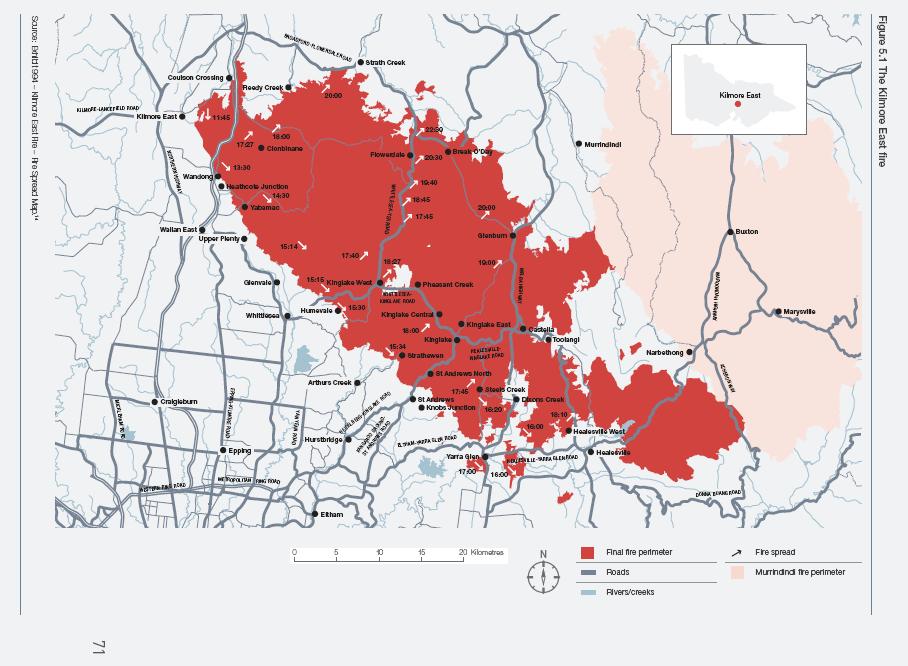 Kilmore East Fire Victoria
Started by Government neglect on 7th February 2009 Kilmore East Fire Victoria
Started by Government neglect on 7th February 2009
.
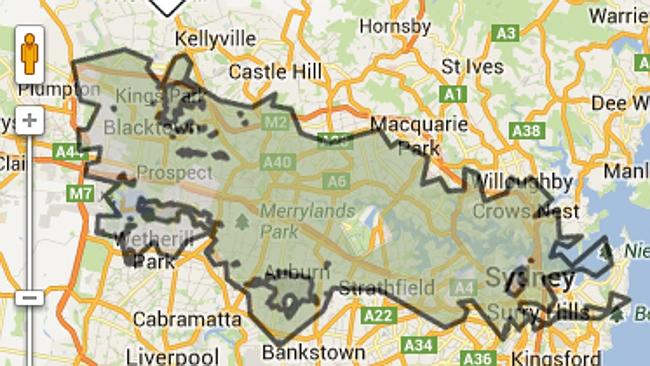 Comparative scale of the State Mine Fire (Lithgow, NSW)
Started by Government neglect on 16th October 2013
..that diverted critical firefighting resources from Winmalee Comparative scale of the State Mine Fire (Lithgow, NSW)
Started by Government neglect on 16th October 2013
..that diverted critical firefighting resources from Winmalee
.
.
[Source: ‘O’Farrell fans flames of frustration as experts warn it is time to act‘, 20131103, by Rick Feneley, News and features writer, Sydney Morning Herald, ^http://www.smh.com.au/federal-politics/political-news/ofarrell-fans-flames-of-frustration-as-experts-warn-it-is-time-to-act-20131102-2wtdq.html]
.
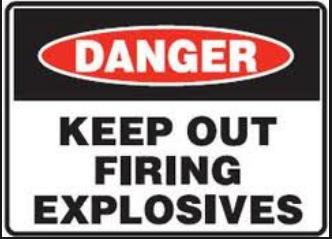
.
Monday, September 30th, 2013
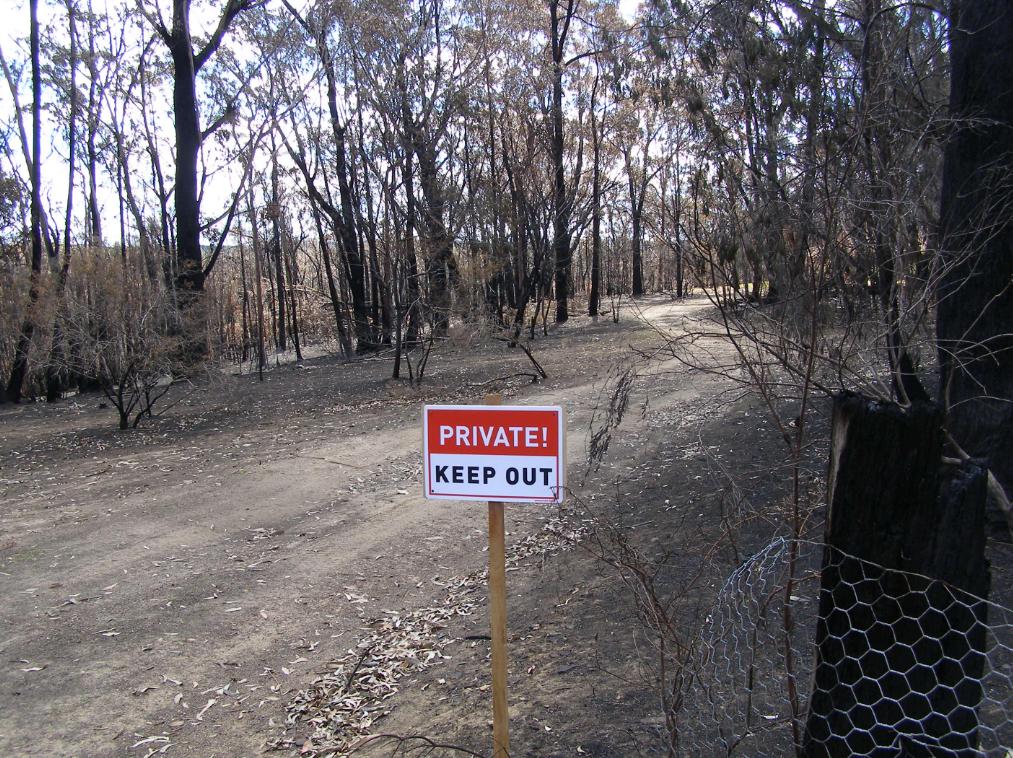 Hawkesbury Heights hazard reduction negligence
Well our fire “escaped”. Sorry, we’re immune from prosecution. Hawkesbury Heights hazard reduction negligence
Well our fire “escaped”. Sorry, we’re immune from prosecution.
[Photo by our Investigator along Hawkesbury Road, Blue Mountains, Australia, 20130921, photo © under ^Creative Commons]
.
Partners in crime: big ego Blue Mountains National Parks with even bigger ego Blue Mountains RFS, have jointly stuffed up big this time.
.
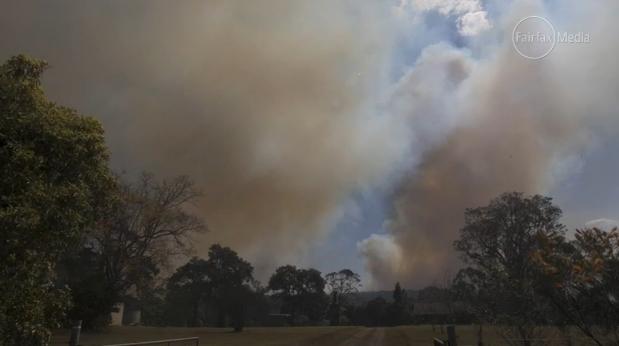 A hazard reduction north of the Hawkesbury Road from the previous weekend was left abandoned.
A few days later the forecast wind picked up and voila: HR come wildfire. Woops.
Sound familiar? Warrumbungles (2013), Macleay River (2012), Grose Valley (2006), Canberra Firestorm (2003) A hazard reduction north of the Hawkesbury Road from the previous weekend was left abandoned.
A few days later the forecast wind picked up and voila: HR come wildfire. Woops.
Sound familiar? Warrumbungles (2013), Macleay River (2012), Grose Valley (2006), Canberra Firestorm (2003)
[Source: Fairfax, ^http://www.smh.com.au/nsw/hazard-reduction-burn-started-major-sydney-bushfire-20130913-2tois.html]
.
Hawkesbury Heights residents will recall last year’s escaped hazard reduction along the Springwood Ridge inside the Blue Mountains National Park. It was left for few days, then the forecast prevailing sou’wester picked up on 30th August 2012. The fire jumped containment lines then threatened the Bowen Mountain community to the nor’ east.
<<More than 30 firefighters from the NSW Rural Fire Service and National Parks and Wildlife Service have worked behind homes in the community of Bowen Mountain to contain this fire. Crews backburned to establish containment lines around the fire with the assistance of helicopters and earth moving machinery.>>
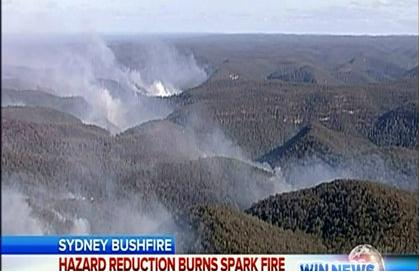 National Park ablaze thanks to government-sanctioned arson National Park ablaze thanks to government-sanctioned arson
[Source: Blue Mountains RFS, ^ http://www.bluemountains.rfs.nsw.gov.au/dsp_more_info_latest.cfm?CON_ID=18199, Reference will probably disappear within days of publication.]
How much did that stuff up cost? This is where donations to the RFS are going.
The Habitat Advocate reconstructs that the HR folly at Hawkesbury Heights two weeks ago probably unfolded as follows:
Blue Mountains National Parks decides that its a good idea to set fire to the Blue Mountains National Park along Shaws Ridge. Shaws Ridge is over two kilometres from the Hawkesbury Road. It has nothing to do with ‘asset protection’ to private properties. So the Parks Service just calls it ‘strategic’ or an ‘ecological burn’ – good for the bush.
“Generally over an 8-12 year cycle it [vegetation] needs to be burnt, which allows it to regenerate.” ~ Blue Mountains RFS district manager David Jones, 20130918.
The bush and its wildlife likes being burnt. Parks Service’s gospel Fire Maps shows in bright red that this part of the protected Blue Mountains National Park (World Heritage Area) hasn’t been burnt for 8 years, so it must to be burned, just in case it burns!
So the fire cult’s mindset is fixated. Parks Service includes the area to its annual hazard reduction burning programme and checks the weather forecast. The Bureau of Meteorology forecasts low winds but with expected changes later in the week. She’ll be right. The job will be over in a day. Parks Service sees the low wind HR window and goes for it.
Parks Service musters up their fire friendly mates at the RFS down at Winmalee and Hawkesbury Heights and complicitous stations. The HR is on! So all the cracks had gathered to the fray. All the tried and noted firies from the stations near and far mustered along Shaws Ridge fire trails. For the firies love the smell of wood smoke along the fire trails and the old red Isuzu’s snuff the battle with delight.
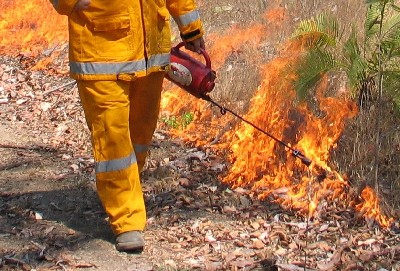 Hazard Reduction: Reducing the World Heritage Hazard
‘Cos see when there’s a real wildfire, Dad’s Army can’t cut the mustard Hazard Reduction: Reducing the World Heritage Hazard
‘Cos see when there’s a real wildfire, Dad’s Army can’t cut the mustard
.
The hazard reduction proceeds on the Sunday 8th September with hardly a breeze in hilly timbered terrain, using trucks only along ‘fire’ trails. We won’t need choppers. They’ll only blow the budget. Sunday night falls, job done and the vols go home. Monday a bit windy, then Tuesday really warm and the wind picks up, gusty to blazes.
The media reports as follows:
<<A hazard-reduction burn that got out of control sparked one of four major bushfires that ravaged western Sydney and the Blue Mountains this week, fire authorities have revealed.
NSW Rural Fire Service Deputy Commissioner Rob Rogers said the National Parks and Wildlife Service had been conducting a hazard-reduction burn near Hawkesbury Road in Winmalee last weekend, which flared up in Tuesday’s soaring temperatures and high winds. [Ed: Winmalee? Close, but try Hawkesbury Heights further north.]
Rob Rogers:
“Basically it was burnt on the weekend, it was patrolled on Monday, there was smouldering activity. That fire then jumped containment lines [on Tuesday].”
.

.
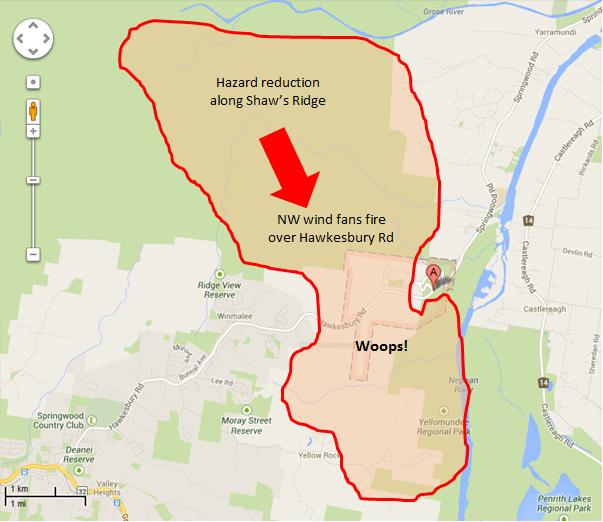 The Parks Service and RFS secretively keep fire operational matters behind closed doors for fear of embarrassment and of being sued.
So our research investigator conducted a post-fire inspection on Saturday 20130921 and has estimated the above impact and scenario.
Perhaps those in charge can prove us wrong? We invited them to.
[Source: The Habitat Advocate, assisted with Google Maps] The Parks Service and RFS secretively keep fire operational matters behind closed doors for fear of embarrassment and of being sued.
So our research investigator conducted a post-fire inspection on Saturday 20130921 and has estimated the above impact and scenario.
Perhaps those in charge can prove us wrong? We invited them to.
[Source: The Habitat Advocate, assisted with Google Maps]
.
<<Just 10 minutes earlier the family had been told by firefighters to remain calm before a freak wind change sent the blaze roaring uphill towards their house. “Evacuate” was the order.>>
[Source: ‘I put my foot down and drove through the fire’: Mother tells how she fled with children in Winmalee’, 20130911, by Taylor Auerbach, The Daily Telegraph, ^http://www.dailytelegraph.com.au/news/nsw/i-put-my-foot-down-and-drove-through-the-fire8217-mother-tells-how-she-fled-with-children-in-winmalee/story-fni0cx12-1226716604185]
.
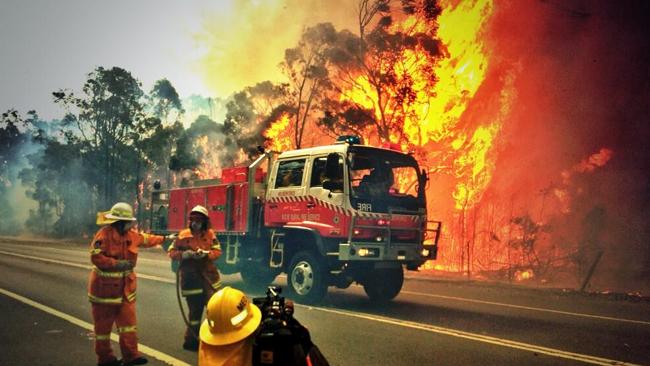 Tackling the Winmalee Hazard Reduction come Wildfire on Hawkesbury Road.
Heroes extinguishing the neglect of their Parks Service cousins. Tackling the Winmalee Hazard Reduction come Wildfire on Hawkesbury Road.
Heroes extinguishing the neglect of their Parks Service cousins.
.
<<A fire burning in the area of Hawkesbury Road at Winmalee has already claimed one property, with more than 100 firefighters working to contain the blaze. Five firefighters have suffered from smoke inhalation and two received minor burns battling the fire in Winmalee.>>
[Source: ‘Bushfire burns Winmalee home, others at risk in Blue Mountains’, 20130910, Sydney Morning Herald, Photo by Nick Moir, ^http://www.smh.com.au/nsw/bushfire-burns-winmalee-home-others-at-risk-in-blue-mountains-20130910-2ths1.html]
.
<< Firefighters have contained a blaze that has burnt through more than 1000 hectares of bushland west of Sydney. The fire, at Winmalee in the Blue Mountains, has been burning since Tuesday fanned by high temperatures and strong winds, plunging the region into emergency. Firefighters were still water bombing the burning bushland on Thursday.
The Rural Fire Service on Friday said the fire had been contained.
RFS spokeswoman Laura Ryan:
“It was brought fully under control last night just before a community meeting at Winmalee High School. Firefighters (unpaid) would today work to extinguish the blaze, but said it was too early to say how long that would take. Firefighters will be working hard to get every bit of that fire out.”
The RFS and NSW Police say they have launched investigations into the cause of the bushfire, with some locals raising concerns that recent hazard reduction burns in the area may be responsible. [Ed: NSW Police need not investigate far beyond the operational records of the Blue Mountains National Parks and Wildlife Service, with internal documents circulated to the RFS]
.
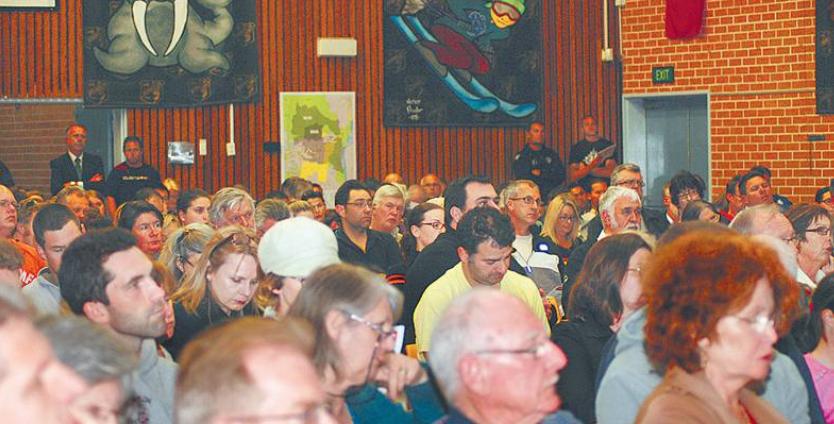 More than 350 Blue Mountains residents pack the Winmalee High School on Thursday night 12th September, fearful whether they could lose their homes to Hazard Reduction.
[Source: ^http://news.ninemsn.com.au/national/2013/09/13/07/00/winmalee-bushfire-contained-rfs]
More than 350 Blue Mountains residents pack the Winmalee High School on Thursday night 12th September, fearful whether they could lose their homes to Hazard Reduction.
[Source: ^http://news.ninemsn.com.au/national/2013/09/13/07/00/winmalee-bushfire-contained-rfs]
.
<< A Rural Fire Service organised community meeting held last week at Winmalee to discuss the fire situation in Winmalee and Yellow Rock was well attended.
Winmalee and Yellow Rock residents aired their bushfire concerns at a community meeting organised by the NSW Rural Fire Service (RFS) at Winmalee High School last Thursday night.
Despite the meeting only being publicised that day, the school hall was nearly full with 350 residents. At least 10 people in the room did not receive an RFS emergency safety warning text message to take shelter.
Blue Mountains RFS district manager David Jones said he would, “feed that back up the line … it may be a service provider issue, I’m not sure, that may be part of it” and that he would look further into the issue.
A Yellow Rock resident asked what hazard reduction burns would take place in Yellow Rock in the near future.
Supt Jones said the weather conditions last week hadn’t been suitable to maintain control of a backburn.
“It’s a one-way, one-road in and its never received the recognition it deserves on that basis in terms of protection,” the Yellow Rock resident said. “I would hate to see a real emergency situation develop here at Yellow Rock.”
Supt Jones said he’d look at the RFS organising a meeting with Yellow Rock residents in the near future to address these issues. Supt Jones said residents could have a fire mitigation officer assess if hazard reduction was needed in their area by lodging a hazard complaint with the RFS.
“Generally over an 8-12 year cycle it [vegetation] needs to be burnt, which allows it to regenerate,” he said.
National Parks and Wildlife Service (NPWS) Upper Mountains area manager Richard Kingswood said there weren’t many days a year suitable for conducting hazard reduction burns — only 10 days in the Upper Mountains and a few more in the Lower Mountains, although last autumn and spring had provided more opportunities. He said in the last financial year NPWS had initiated 38 burning operations over 50,000 hectares, which was more than usually occurred.
Another resident asked why, with safety concerns with overhead powerlines, they couldn’t go underground, especially as the highway was being widened. An Endeavour Energy spokesman said cost was an issue. “It costs about 10 times more to put mains underground.”
Others were concerned about issues around road blocks, where children as well as adults were allowed to walk past roadblocks to return home, yet people couldn’t get their vehicles through. It didn’t make sense from a safety perspective, the resident said.>>
[Source: ‘Concerns aired at Winmalee fire meeting’, 20130918, by Ilsa Cunningham, Blue Mountains Gazette, ^http://www.bluemountainsgazette.com.au/story/1782194/concerns-aired-at-winmalee-fire-meeting/]
.
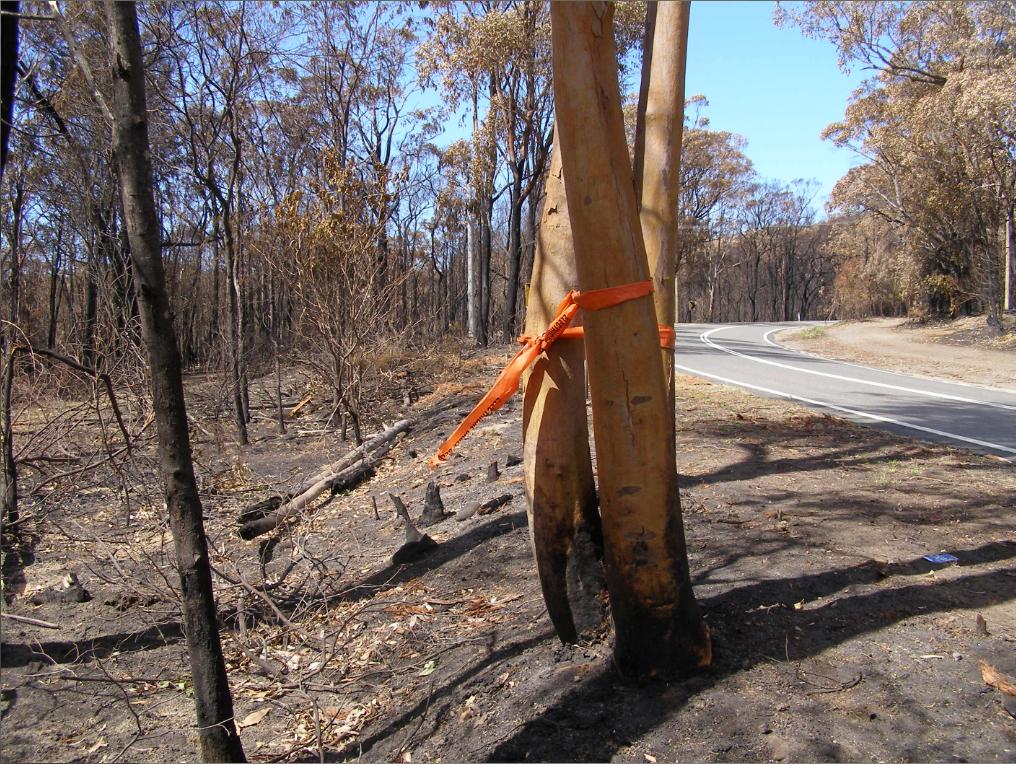 Hawkesbury Road well and truly hazard reduced
[Photo by our Investigator along Hawkesbury Road, Blue Mountains, Australia, 20130921, photo © under ^Creative Commons] Hawkesbury Road well and truly hazard reduced
[Photo by our Investigator along Hawkesbury Road, Blue Mountains, Australia, 20130921, photo © under ^Creative Commons]
.
<< More than 1200 firefighters were involved in battling the four major fires on Tuesday along Hawkesbury Road in Winmalee; in Marsden Park in the Blacktown area; near Tickner Road in Castlereagh; and Richmond Road at Windsor. Fourteen helicopters and 350 trucks from the Rural Fire Service, Fire and Rescue NSW and the National Parks and Wildlife Service were involved in the firefight.
Just before 1.30pm on Tuesday, the temperature in Sydney was 31.6 degrees. Mr Rogers said strong wind also made fire conditions worse, with gusts reaching 90 kilometres an hour, which was much higher than forecast.
He said RFS firefighters helped in the hazard-reduction operation in Winmalee, which was under the supervision of the NPWS, and he apologised to anyone who experienced property damage.
“Combined with the winds, how dry it is, the temperature and the steep terrain, fire takes hold very, very quickly.”
He said the RFS also was investigating whether a hazard-reduction burn escaped and forced the closure of the M1 (formerly the F3) Motorway on Thursday.
“You would have to obviously be suspicious that it did come from a hazard-reduction, given that it was in a very close proximity to it. That’s something that we’re going to be looking at very, very closely,” he said.>>
<<Fire authorities have issued an emergency warning for a bushfire threatening homes in Castlereagh in Sydney’s west, and alerts for other out of control bushfires in Blacktown and Hawkesbury.
NSW Rural Fire Service Deputy Commissioner Rob Rogers said National Parks and Wildlife Service had been conducting a hazard reduction burn near Hawkesbury Road in Winmalee last weekend. The fire flared with Tuesday’s soaring temperatures and high winds.
..He apologised to anyone who experienced property damage from the Winmalee fire. ”..It appears on first look that it’s a case of the weather was worse than was predicted, the fire jumped out, it took hold really..quickly.” >>
Even though the fire ripped through Hawkesbury Heights, the National Parks and Wildlife Services has released a public notice asking any Winmalee residents who experienced property damage or loss have been urged to contact NPWS on 1300 361 967 for sympathy and counselling.
New South Wales Rural Fire Service (paid) Deputy Commissioner Rob Rogers has said that his (unpaid) RFS firefighters helped in the hazard-reduction operation in Winmalee, which was under the supervision of the NPWS, and he apologised to anyone who experienced property damage.
.
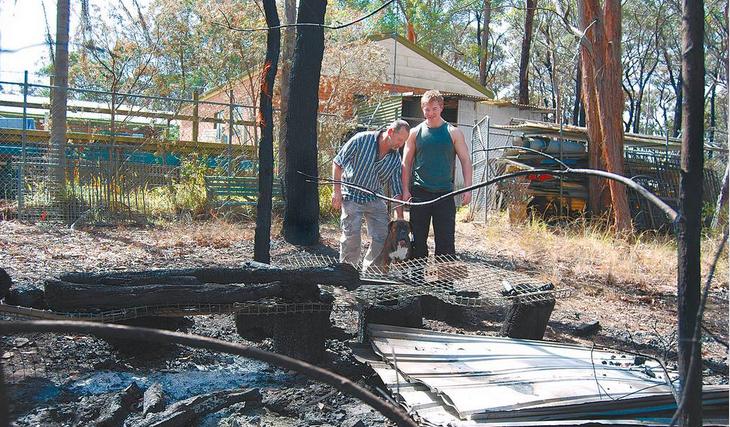 RFS: Sorry about that
Property loss at Hawkesbury Heights (Wheatley Road?) but who pays?
Owner: “we won’t need hazard reduction for a while.”
[Source: ‘Bushfire wake-up call’, 20130918, by Shane Desiatnik,
^http://www.theleader.com.au/story/1782048/bushfire-wake-up-call/] RFS: Sorry about that
Property loss at Hawkesbury Heights (Wheatley Road?) but who pays?
Owner: “we won’t need hazard reduction for a while.”
[Source: ‘Bushfire wake-up call’, 20130918, by Shane Desiatnik,
^http://www.theleader.com.au/story/1782048/bushfire-wake-up-call/]
.
[Sources: ‘Hazard reduction burn started major Sydney bushfire’, by Megan Levy, 20130913, ^http://www.smh.com.au/nsw/hazard-reduction-burn-started-major-sydney-bushfire-20130913-2tois.html; and ‘Burn-offs and arson suspected as cause of two bushfires’, by Megan Levy and Peter Hannam, 20130914, ^http://www.smh.com.au/nsw/burnoffs-and-arson-suspected-as-cause-of-two-bushfires-20130913-2tq15.html]
.
National Parks and Wildlife Advisory Council Report
(42nd meeting held on 28-29 May 2013)
.
<< Council noted the following details regarding the current status of fire management activity by NPWS:
- The 135 000ha annual target has been met with a total of 176 000ha now treated.
- Almost 3 times more area treated than the average for last five years.
- 6-7000ha hazard reduction activity planned over the next week.
- Opportunity to increase positive community profile for NPWS.
- Statewide strategy with performance indicators in place at state and regional levels. >>
.
[Source: New South Wales Government, NSW National Parks and Wildlife Service, ^http://www.environment.nsw.gov.au/resources/about/NPWAdvisoryCouncMay2013.pdf]
.
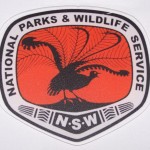 In Parks we Trust In Parks we Trust
.
In New South Wales the National Parks and Wildlife Act became law on 1 October 1967. The legislation created a single agency, the National Parks and Wildlife Service, to care for, control and manage the original nineteen parks and any new ones created in the future.
.
.
.
Further Reading:
.
[1] ‘NPWS Fire Fighters Recognised for Service as NSW Gets 10 Year Fire Plan‘, 20130422, NSW Government, ^http://www.environment.nsw.gov.au/resources/MinMedia/MinMedia13042201.pdf
.
[2] ‘National Parks and Wildlife Advisory Council Report‘, 42nd meeting held 20130528-29, NSW Government, ^http://www.environment.nsw.gov.au/resources/about/NPWAdvisoryCouncMay2013.pdf
.
[3] ‘Fire Management Manual, 2012-2013‘, NSW National Parks and Wildlife Service, NSW Government, ^http://www.environment.nsw.gov.au/resources/firemanagement/final/OEH20120645FireMgmtManual.pdf
.
[4] ‘Blue Mountains National Park Plan of Management‘, May 2001, NSW National Parks and Wildlife Service, ^http://www.environment.nsw.gov.au/resources/parks/pomfinalbluemountains.pdf
.
[5] ‘Greater Blue Mountains World Heritage Area – Strategic Plan‘, January 2009, Department of Environment and Climate Change (NSW) with funds supplied by the Australian Government, ^http://www.environment.nsw.gov.au/resources/parks/StategicPlanNPWS.pdf
.
[6] ‘National parks and forest conservation‘, 2006, by Brett J. Stubbs, School of Environmental Science and Management, Southern Cross University, Lismore, New South Wales ^http://fennerschool-associated.anu.edu.au/environhist/links/publications/anzfh/anzfh1stubbs.pdf
.
Tags: Blue Mountains, bush arson, Greater Blue Mountains World Heritage Area, Hawkesbury Heights, Hawkesbury Road, Hawkesbury Road Winmalee Fire, hazard reduction, hazard reduction out of control, National Parks and Wildlife Service, NSW Rural Fire Service, Shaws Ridge, Winmalee Hazard Reduction, Yellow Rock
Posted in Blue Mountains (AU), Threats from Bushfire | 2 Comments »
Add this post to Del.icio.us - Digg
Sunday, September 29th, 2013
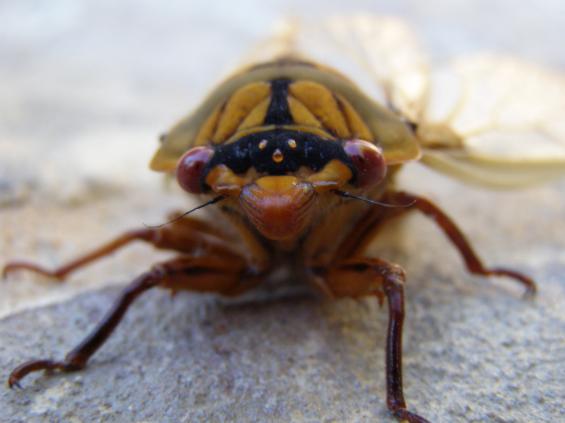 Yellow Monday Cicada (Cyclochila australasiae)
After seven years subterranean dormancy, they’re back chirping in the trees, and it sounds like summer again!
[Photo by Editor 20130928, photo © under ^Creative Commons] Yellow Monday Cicada (Cyclochila australasiae)
After seven years subterranean dormancy, they’re back chirping in the trees, and it sounds like summer again!
[Photo by Editor 20130928, photo © under ^Creative Commons]
.
The shrill rhythmic cacophony of cicadas is one of Australia’s most memorable sounds of summer.
Cicadas are the loudest insects in the world and there are more than 200 species in Australia. The Yellow Monday Cicada (pictured above) is also commonly known as the Green Grocer (and formerly as the Great Green Cicada). It is about 4 cm long and has variants of colour, green or gold, but always with red compound eyes. It also has three simple eyes (‘ocelli‘) in the centre of its head, which are harder to see. These serve to help it to detect light intensity, its orientation to the sun, and are likely to assist in flight stability.
Cicadas spend nearly all their life dormant in nymph form sustained by imbibing sap from nearby trees, shrubs and grass roots underground.
In Australia, after about seven years and prompted by the onset of warm rainwater at or above 18 degree Celsius percolating down the soil, they emerge from the earth as pupae crawling vertically upwards. They leave mud tunnels to the surface which become signature holes in the ground. They climb above ground to safety, usually up the nearest tree.
.
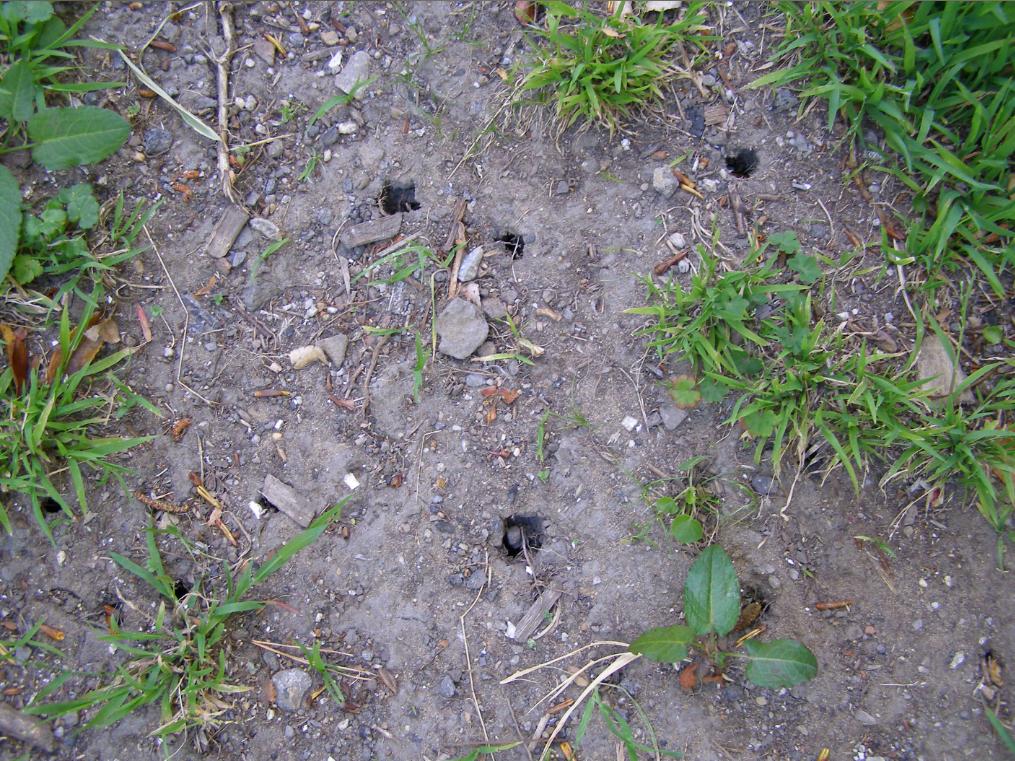 Cicada pupae mud tunnels, often in lawns below trees.
These are commonly mistaken to be Funnel Web Spider funnels.
Best NOT to put your finger down the hole to find out.
[Photo by Editor 20130929, photo © under ^Creative Commons]
Cicada pupae mud tunnels, often in lawns below trees.
These are commonly mistaken to be Funnel Web Spider funnels.
Best NOT to put your finger down the hole to find out.
[Photo by Editor 20130929, photo © under ^Creative Commons]
.
Here they metaphorphose into adults, shedding their exoskeleton (exuvia). The fully-winged adult cicadas emerge leaving their old empty nymphal skin behind and become capable of short flight. This all happens within days and hundreds of shed exuvia are commonly seen on tree trunks in gardens and bushland during the summer months.
A day or two passes for them to gain strength before they are able to climb into tree canopies and start their mating call. Metaphorphosis must be an energy sapping experience.
As adult cicadas, they only live for six weeks; fly around, mate, and breed over the summer, then die.
.
“We are like butterflies who flutter for a day and think it is forever.”
.
~ Carl Sagan (b.1934)
.
After mating, the female cuts slits into the bark of a twig, and into these she deposits her eggs. This can be repeated until she has laid several hundred eggs. When the eggs hatch, the newly hatched nymphs drop to the ground, where they burrow. The lifecycle of the cicada thus continues.
The lifecycle in Australia is generally seven years, but for some species can be as little as two years, or in some parts of the world up to seventeen years.
.
Cicada Chirping
.
The male circadas make loud shrill calls to attract females to mate. Each cicada species has a unique song to attract only its own kind.
The loud chirping calls of the male are heard over the summer months; harsh and high-pitched, these may reach 150 decibels. The sound is made by the rapid buckling of the timbal ribs, and amplified by resonation in an air sac; the frequency is around 4.3 kHz. Both male and female cicadas have organs for hearing. A pair of large, mirror-like membranes, the tympana, receive the sound. The tympana are connected to an auditory organ by a short tendon. When a male sings, it creases the tympana so that it won’t be deafened by its own shrill mating call.
Male mating calls typically occur during the day when sunny and at or above 18 degree Celsius, to compete to attract females.
The loudness of the cicada chorus is also thought to help repel predatory birds, probably because the noise is painful to birds’ ears interfering with their normal communication. The males of many cicada species, including the Greengrocer/Yellow Monday, and the Double Drummer, tend to group together when calling which increases the total volume of noise and reduces the chances of bird predation.
.
The Yellow Monday Cicada is naturally distributed from south-eastern Queensland through eastern New South Wales and Victoria to the Grampians, and through to Mount Gambier in south-eastern South Australia. It is common along the Great Dividing Range, and is also found in the Warrumbungles. It is commonly seen (and heard) around Sydney and Melbourne, the Blue Mountains and Gippsland. In Brisbane, it is only encountered at elevations above 300 m (1000 ft). It was associated with the White Stringybark (Eucalyptus globoidea) in a study at three sites in western Sydney.
Cicadas are so conspicuous that many of their common names were initially given to them by children. As a result cicadas probably have the most colourful common names in the insect world. Some of these include the Black Prince (Psaltoda plaga), Double Drummer, Floury Baker, and the Yellow Monday.
.
.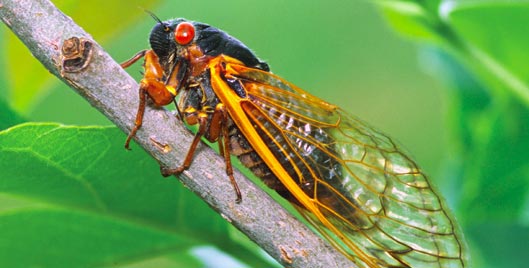 An adult Cicada in habitat
[Source: ‘Festival of the Cicadas’, by Craig Vetter,
^http://www.chicagowilderness.org/CW_Archives/issues/spring2007/cicadas.html]
An adult Cicada in habitat
[Source: ‘Festival of the Cicadas’, by Craig Vetter,
^http://www.chicagowilderness.org/CW_Archives/issues/spring2007/cicadas.html]
.
.
“The world is full of magic things, patiently waiting for our senses to grow sharper.”
.
~ W.B. Yeats (b.1865)
.
.
References and Further Reading:
.
[1] The Australian Museum, ^http://australianmuseum.net.au/Cicadas-Superfamily-Cicadoidea
[2] ‘Greengrocer or Yellow Monday Cicada’, Climate Watch, ^http://www.climatewatch.org.au/species/insects/greengrocer-or-yellow-monday-cicada
[3] ‘Cyclochila australasiae’, ^http://en.wikipedia.org/wiki/Cyclochila_australasiae
[4] ‘Summer of singing cicadas’, by Owen Craig, ABC Science, ^http://www.abc.net.au/science/articles/2001/02/17/2822486.htm
[5] Moulds, M.S. 1990. Australian Cicadas. New South Wales University Press. 217 pp., 24 pls. (Also publications in 1992, 1994, 1996, 1998).
[6] ‘Cicada’, Wikipedia, ^http://en.wikipedia.org/wiki/Cicada
[6] Clyne D (1998). Cicada Sing-Song. Gareth Stevens Publishing, Milwaukee. USA.
[7] Ewart A (1990). Status of the Germar and Leach types of Australian cicadas (Homoptera) held at the Hope Entomological Collections, Oxford. Australian Entomological Magazine 17(1): 1-5
[8] Gwynne DT, Yeoh P and Schatral A(1988). The singing insects of King’s Park and Perth gardens. Western Australian Naturalist 17(2-3): 25-71
[9] Hill KG and Hill CE (1979). Acoustic behaviour of the bladder cicada Cystosoma saundersi. Australian National University Research School of Biological Sciences Annual Report – 1979: 122.
[10] Hayashi M and Moulds MS (1999). Observations on the eclosion of the hairy cicada, Tettigarcta crinita Distant (Homoptera: Cicadoidea: Tettigarctidae). Australian Entomologist 25(4): 97-101
[11] MacNally RC (1988). Simultaneous modelling of distributional patterns in a guild of eastern-Australian cicadas. Oecologia (Berlin) 76(2): 246-253.
[12] MacNally RC and Doolan JM (1986). Patterns of morphology and behaviour in a cicada guild: a neutral model analysis. Australian Journal of Ecology 11(3): 279-294.
.
Thursday, September 26th, 2013
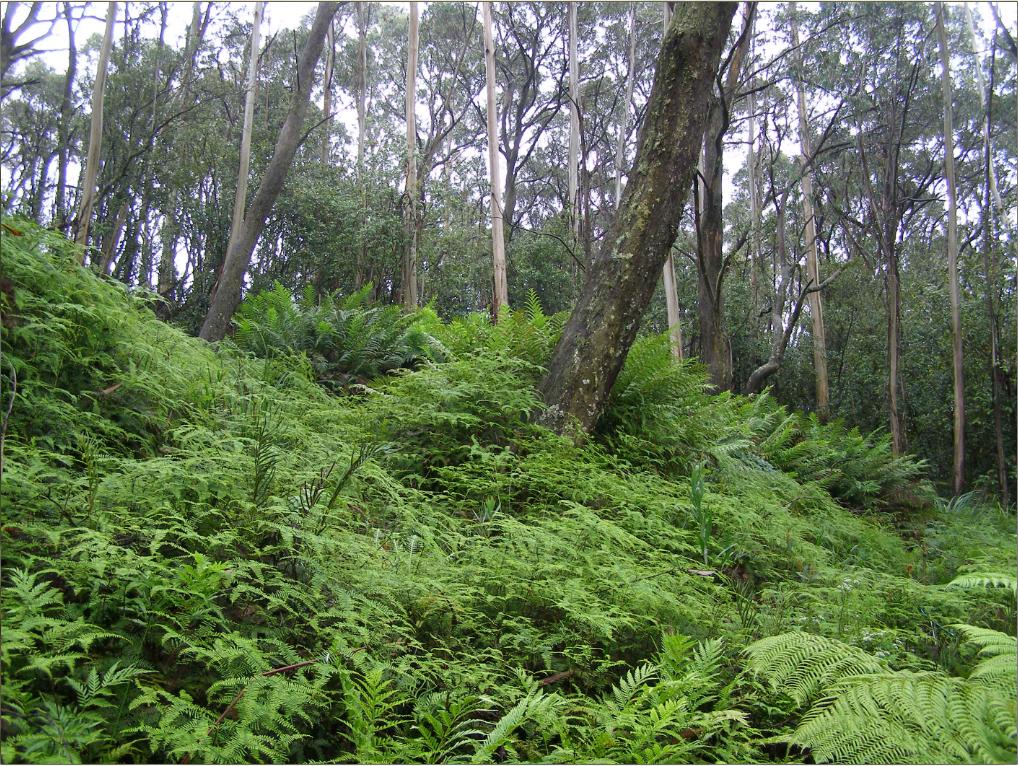 This is a Blue Mountains Swamp
It is a surviving remnant of Blue Mountains Swamps in the Sydney Basin Bioregion ecological community, which in 2005 were listed as Endangered by the Commonweath Threatened Species Scientific Committee.
[Photo by Editor 20120128, photo © under ^Creative Commons]
Click image to enlarge This is a Blue Mountains Swamp
It is a surviving remnant of Blue Mountains Swamps in the Sydney Basin Bioregion ecological community, which in 2005 were listed as Endangered by the Commonweath Threatened Species Scientific Committee.
[Photo by Editor 20120128, photo © under ^Creative Commons]
Click image to enlarge
.
Blue Mountains Swamps?
.
Blue Mountains Swamps are globally restricted to the Central (and upper) Blue Mountains and to Newnes Plateau at altitudes between 600 m to 1200 m AMSL. They exist on peat soils above a sandstone substrate geomorphology. The soil tends to be water logged due to the presence of constant groundwater seeping over the impermeable claystone layers in the sandstone which impedes their drainage, however some swamps can be constantly flooded or else ephemeral, varying with seasonal rainfall patterns and more long term with El Niño/La Niña climatic phases.
Blue Mountains Swamps are typically situated at the headwaters of watercourses below ridges, but can also be hanging swamps on steep ridges, or valley bottom swamps. The structure and species composition of Blue Mountains Swamps varies with localised geology, topographic location, depth of the water table, extent and duration of water logging, drainage gradients, sedimentation and soil type.
Blue Mountains Swamp vegetation structure can range from being open or closed variants of sedgeland, rushland, heath, tussock grassland, tussock grassland, tall grassland, scrub and tall shrubland. The vegetation is typically under 3 metres in height, although taller shrubs may be present. Emergent tree species favouring wet root systems can occur on the swamp margins, and the vegetation here tends to be closed woodland in their undisturbed natural state.
Both the structure and species composition of swamp vegetation vary from site to site, and the individual species and structural types shown below do not all occur at every site. Within a single swamp area a complex mosaic of vegetation types (structure and species composition) may be present.
The structure of Temperate Highland Peat Swamps on Sandstone vegetation includes sedgeland, closed sedgeland, open-rushland, open-heath, closed-heath, tussock grassland, closed-tussock grassland, tall closed-grassland, open-scrub and tall shrubland. The vegetation is usually less than 3 m in height, although taller shrubs may be present. Emergent trees may occur on swamp margins, and the vegetation here tends to open woodland.
Typical vegetation is characterised by the presence of sedges, graminoids (grass-like plants) and forbs (herbaceous non-grass or grass-like plants) with or without shrubs. They are endemic to the upper Blue Mountains, comprising numerous small patches which aggregate to being about 3,000 heactares in total area. They occur naturally nowhere else on the planet.
Blue Mountains Swamps are scientifically included as a class within the nationally recognised Temperate Highland Peat Swamps on Sandstone ecological community. On 29th April 2005, Temperate Highland Peat Swamps on Sandstone was included in the list of nationally threatened ecological communities under section 181 of Australia’s Environment Protection and Biodiversity Conservation Act 1999. [Source: ^http://www.comlaw.gov.au/Details/F2005L01134]. This was mainly due to Threatened Species Scientific Committee recognising its limited distribution and vulnerability to ongoing threats.
It followed a ten year campaign by Blue Mountains environmentalists..
.
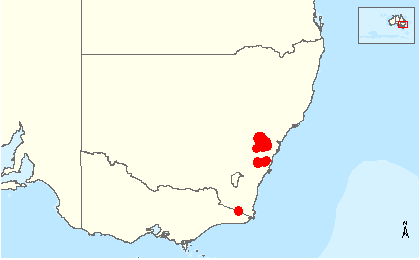 Global distribution map of Temperate Highland Peat Swamps on Sandstone ecological community.
[Source: Temperate Highland Peat Swamps on Sandstone, Biodiversity, Species Profile and Threats Database, Department of the Environment, Australian Government, ^http://www.environment.gov.au/cgi-bin/sprat/public/publicshowcommunity.pl?id=32#status] Global distribution map of Temperate Highland Peat Swamps on Sandstone ecological community.
[Source: Temperate Highland Peat Swamps on Sandstone, Biodiversity, Species Profile and Threats Database, Department of the Environment, Australian Government, ^http://www.environment.gov.au/cgi-bin/sprat/public/publicshowcommunity.pl?id=32#status]
.
Twynam Swamp
.
Twynam Swamp is essentially an upland Blue Mountains Sedge Swamp dominated by coral fern (Gleichenia dicarpa).
It is situated on a hillside at the headwaters of Katoomba Creek in the heart of the distribution area for Temperate Highland Peat Swamps on Sandstone. The swamp here is predominantly a sedge swamp and is permanently water logged, probably due to the localised presence of natural groundwater springs.
This particular upland swamp area features a diverse ecological community including the following indicator swamp flora species:
.
-
Coral Fern (Gleichenia dicarpa),
-
King Fern (Todea barbara)
-
Tasman Flax-lily (Dianella tasmanica)
-
Soft Twig Rush (Baumea rubiginosa)
-
Fork-leaved sundew (Drosera binata)
-
Red-fruit Saw Sedge (Gahnia sieberiana)
-
Alpine Heath (Epacris paludosa)
-
Spreading Rope Rush (Empodisma minus)
-
Mat Rush (Lomandra longifolia)
-
Peat Moss (Sphagnum cristatum) in the ground layer
.
and a range of Hakea and Grevillea shrub species.
.
Characteristic of this upper Blue Mountains ridgeline landscape, above this swamp margin stands emerging Eucalyptus oreades, endemically rare in their own right.
Twynam Swamp is but one of the Blue Mountains Swamps localised fragile ecosystems coming under increased pressure mainly by deforestation for housing development and by frequent bushfires especailly from broadscale hazard reduction regimes. Both practices are not only facilitated by government, but sanctioned and enshrined in legislation, despite being scientifically recognised as key threatened processes.
.
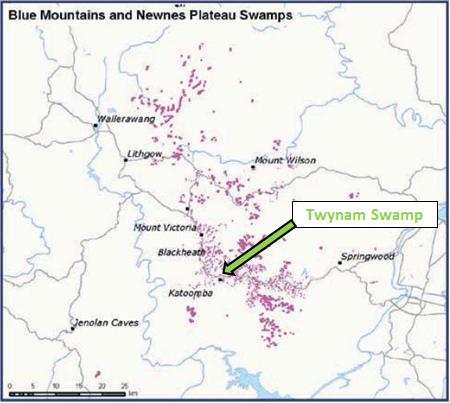 Larger scale distribution map of Blue Mountains and Newnes Plateau Swamps
[Source: ‘Nationally threatened species and ecological communities’, Department of the Environment, Australian Government,
^http://www.environment.gov.au/biodiversity/threatened/publications/pubs/temperate-highland-peat-swamps.pdf] Larger scale distribution map of Blue Mountains and Newnes Plateau Swamps
[Source: ‘Nationally threatened species and ecological communities’, Department of the Environment, Australian Government,
^http://www.environment.gov.au/biodiversity/threatened/publications/pubs/temperate-highland-peat-swamps.pdf]
.
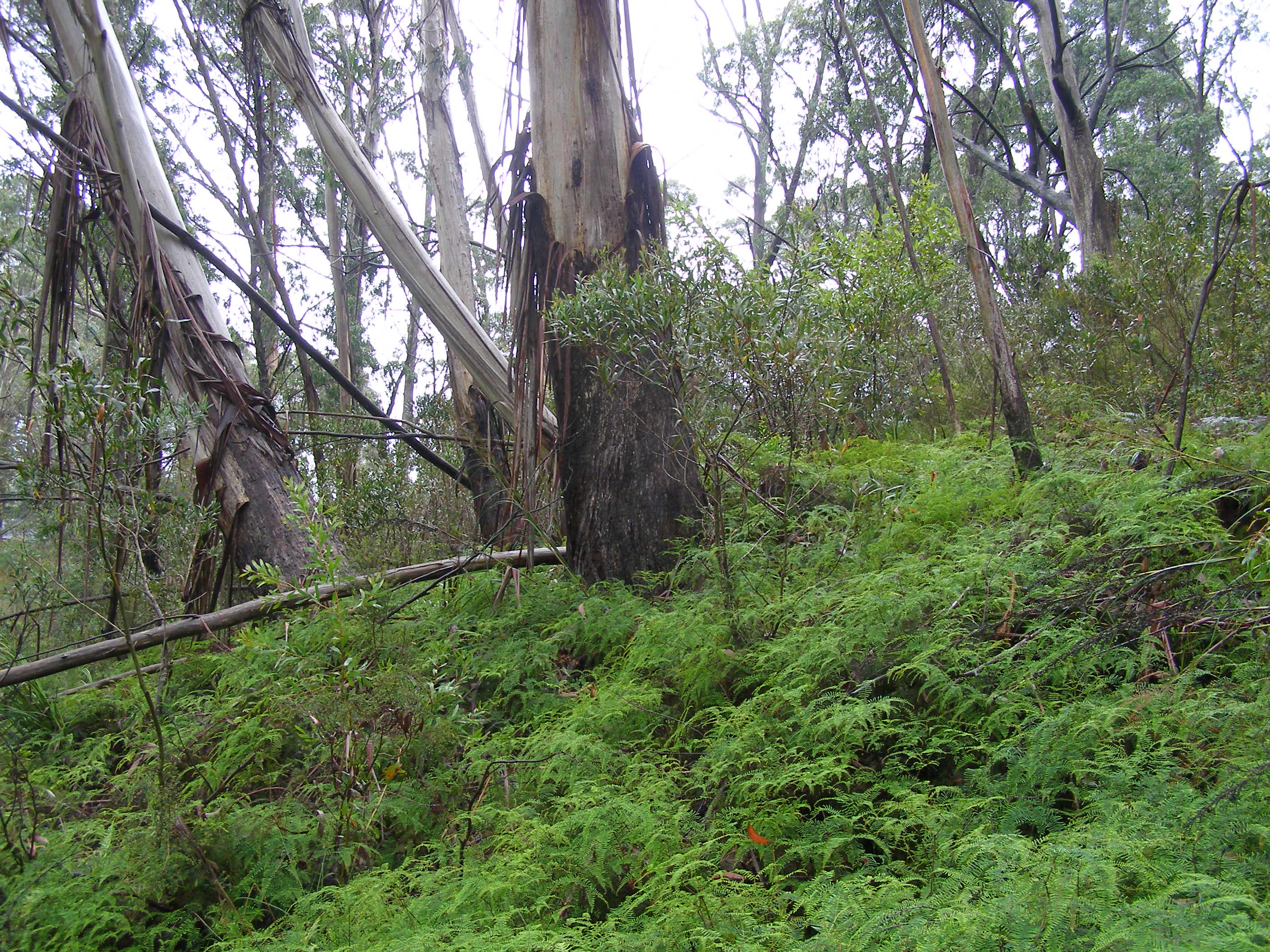 This Blue Mountains Swamp also contains a rare significant stand of Eucalyptus oreades (Blue Mountains Ash) around its periphery, which in itself holds rare ecological value.
[Photo by Editor 20120128, photo © under ^Creative Commons]
Click image to enlarge This Blue Mountains Swamp also contains a rare significant stand of Eucalyptus oreades (Blue Mountains Ash) around its periphery, which in itself holds rare ecological value.
[Photo by Editor 20120128, photo © under ^Creative Commons]
Click image to enlarge
.
But try telling this to the local Blue Mountains Council. Council has just approved the bulldozing through and above this endangered and protected swamp for housing development.
Council’s zoning under its own Local Environment Plan of 1991 actually recognises this particular swamp as being environmentally protected. The swamp covers much of the Katoomba Creek headwaters site that has just been approved for housing development at the end of Twynam Street. It practically adjoins a restricted Sydney Water Catchment area on the ridgetop.
This site is a swamp. It has no connected water, power, gas or telephone. It has no stormwater connection. It is a swamp.
Not surprisingly, the developer’s Flora and Fauna Assessment has concluded that the bulldozing of the swamp will “unlikely.. (cause) any significant impact on any endangered ecological community, population or any threatened species and as such a Species Impact Statement.” [Source: Anderson Environmental Consultants, May 2012, for 121 Twynam Street, p. 13]
So Blue Mountains Council’s Senior Environmental Health and Building Surveyor, Daniel Roberts, approved construction two weeks ago (12th September 2013) for a two storey dwelling and driveway to carve through this Blue Mountains Swamp. The consent conditions for this development application (X/673/2012) read as if the site was just an urban block of land in downtown Sydney; nothing special.
Rules for some?
Still council’s wholesome vision advocates “respecting our heritage and safeguarding our fragile environment” – a clear disconnect between propaganda and practice.
.
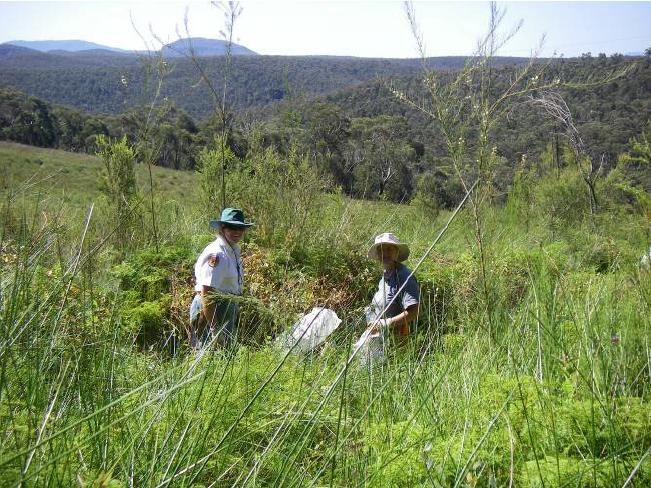 Blue Mountains Swampcare at Kittyhawke Swamp, Wentworth Falls.
Similar swamp characteristics, just more convenient location for Council and Parks Service to jointly show they care.
[Source: Blue Mountains Council’s Upland Swamp Rehabilitation Programme (2007) enticing community volunteers.] Blue Mountains Swampcare at Kittyhawke Swamp, Wentworth Falls.
Similar swamp characteristics, just more convenient location for Council and Parks Service to jointly show they care.
[Source: Blue Mountains Council’s Upland Swamp Rehabilitation Programme (2007) enticing community volunteers.]
.
Ed: To Blue Mountains Council development staff, ‘Temperate Highland Peat Swamps on Sandstone’ national legislation is a discretionary matter depending upon where the swamp happens to be situated.
.
Blue Mountains Council is content to be hypocritical about its stance on protecting Blue Mountains Swamps under its Swampcare Programme, while at the same time its development planning staff authorise destruction of these swamps. It is in flagrant breach of national legislation.
Fortunately, there remain many in the local Blue Mountains community who place high value and have due respect for Blue Mountains Swamps and their need for consistent protection under the national legislation, irrespective of where the swamps happen to be situated. Next door resident, Francis Scarano, has repeatedly objected to the Blue Mountains Council about this development’s certain destructive impact upon the swamp:
.
“The swamp out the front will die along with the E. Oreades as they are not able to cope with excavation for the drive way across roots and concrete next to them and the swamp cannot cope with cut ground water supplies.
What happens when you build above a swamp? You kill a swamp even if you do not build on it. Development above is more than enough to do the job. Winding roads around Eucalyptus oreades grove and building turning bays is enough to make the trees in groves to fall down. Even though the developer is not clearing the oreades grove or swamp his actions will kill them all the same but more slowly.
The swamp particularily depends on the hydrology ie underground springs being undisturbed. They do not understand that building above a swamp will kill it anyway.”
.
Her concerns have fallen on deaf, ignorant ears at Blue Mountains Council.
But council ignorance has not stopped local residents making a stand to save this precious remnant swamp.
.
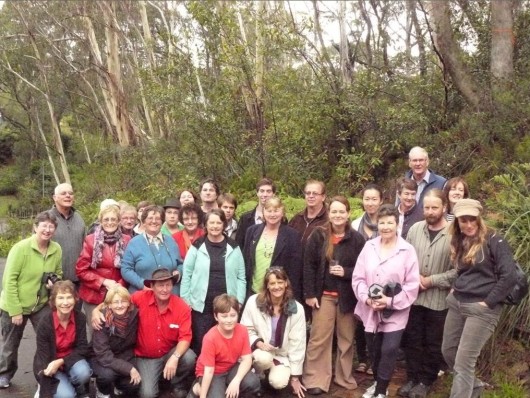 Friends of Twynam Swamp
A collective of friends of Francis Scarano who stand in solidarity with Frances Scarano
to save Twynam Swamp (behind) from the developer’s bulldozer.
[© Photo by Francis Scarano, 20130327] Friends of Twynam Swamp
A collective of friends of Francis Scarano who stand in solidarity with Frances Scarano
to save Twynam Swamp (behind) from the developer’s bulldozer.
[© Photo by Francis Scarano, 20130327]
.
Tags: Alpine Heath, Baumea rubiginosa, Blue Mountains Swampcare, Blue Mountains Swamps, Coral Fern, Dianella tasmanica, Drosera binata, Empodisma minus, Epacris paludosa, Fork-leaved sundew, Gahnia sieberiana, Gleichenia dicarpa, indicator swamp flora species, King Fern, Lomandra longifolia, Mat Rush, Peat Moss, Red-fruit Saw Sedge, Soft Twig Rush, Sphagnum cristatum, Spreading Rope Rush, Tasman Flax-lily, Temperate Highland Peat Swamps on Sandstone, Todea barbara, Twynam Swamp
Posted in Blue Mountains (AU), Threats from Development, Threats from Greenwashing, Threats from Weak Environmental Laws | No Comments »
Add this post to Del.icio.us - Digg
|
|
 A rare and perhaps 150 year old and healthy endemic Eucalpytus Oreades tree
Land buyer: “Hey Asplundh, it’s in the way of where I want to build a house to sell for profit.”
A rare and perhaps 150 year old and healthy endemic Eucalpytus Oreades tree
Land buyer: “Hey Asplundh, it’s in the way of where I want to build a house to sell for profit.”
 A healthy specimen of an Oreades with no signs of disease or rot.
We consider that what took place in Loftus Street Katoomba, Blue Mountains on Monday 25th November 2013, was an act of callous ecological murder
A healthy specimen of an Oreades with no signs of disease or rot.
We consider that what took place in Loftus Street Katoomba, Blue Mountains on Monday 25th November 2013, was an act of callous ecological murder


















































